

How Filipinos Celebrate Christmas
In the Philippines, Christmas is unlike any other. It’s jam-packed with festivities and traditions. Christmas in the Philippines means lights, carols, feasts, and spending time with friends and family. So how do Filipinos celebrate Christmas?
The Christmas spirit is well-known in the Philippines. They take part in one of the world’s longest Christmas seasons. On the islands, Filipino Christmas begins early—in September, to be precise. When the “Ber” months approach, the party begins! Dawn masses, also known as Simbang Gabi, are popular in the Philippines, as are Christmas songs produced by Jose Mari Chan are usually performed in public areas everywhere.
Filipinos can enjoy the festive season and have a happy Christmas within these four months. If you’re a foreigner spending Christmas in the Philippines with your Filipino partner and want to know more about how Filipinos celebrate Christmas, read on, and let’s walk you through!
8 Unique Christmas Traditions In the Philippines
1. christmas starts in september.

The Philippines has the world’s longest and most joyous Christmas season. Visualize Filipinos enjoying the Epiphany, or perhaps the Feast of the Three Kings, for four months, beginning in September and ending in early January.
Unlike those in the United States, Filipino households do not decorate for Halloween and Thanksgiving in October and November. That doesn’t rule out the possibility that they’ve already started decorating. When the first “-ber” month (September) begins, you can expect to see some plastic poinsettias here and there, as well as Santa Claus figures.
It’s not uncommon to see a series of massive Christmas decorations pop up in parks, shopping centers, and open places around the country as early as September. The parol, a Christmas lantern hung on houses or street lights, is a distinctive and popular Christmas ornament. The lantern is shaped like a five-pointed star, which symbolizes the star of Bethlehem that guided the wise men to the manger where Jesus was.
Even though Christmas is still four months away, you can already witness Christmas music being played everywhere, youngsters singing Christmas carols outside of every house, and people exclaiming, “Christmas na!” Even Christmas sales and gift shops try to attract people’s attention, not to forget the rush hours and traffic jams that occur throughout these periods.
2. Christmas songs and carols
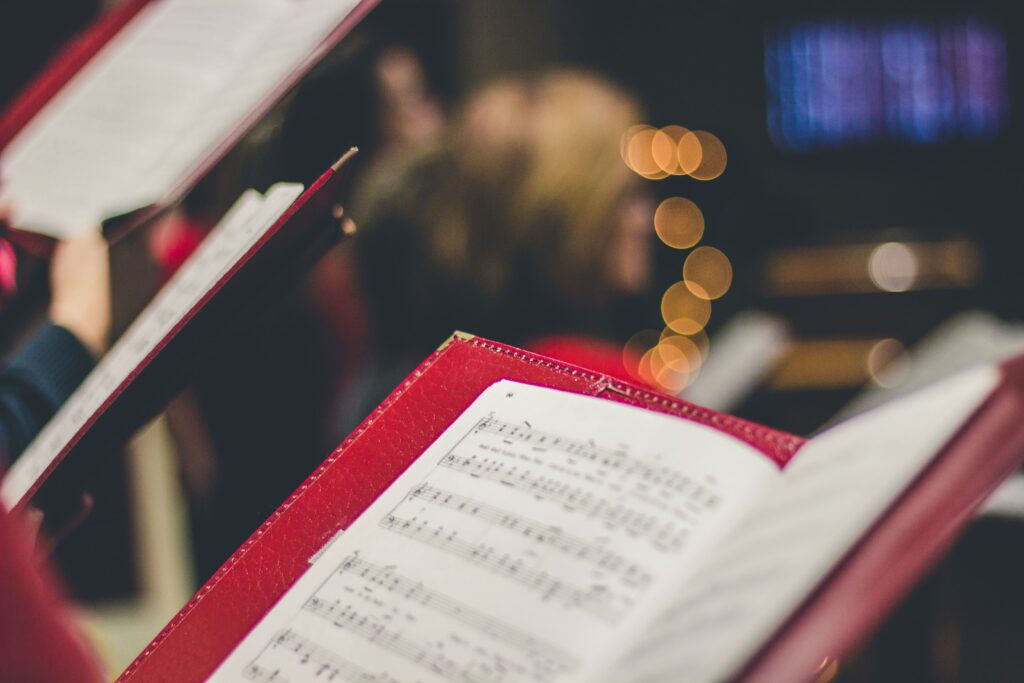
Filipinos are well-known for their musical inclination. Famous songs and carols are a Christmas tradition because it’s the season. What better way to get into the Christmas mood than to listen to Christmas music? Make a playlist of your favorite holiday music, including some that are upbeat and vibrant for festive events and some that are nice and slow for nights spent with a hot cup of hot chocolate.
Jose Mari Chan’s “Christmas In Our Hearts” is one of the most well-known melodies you’ll hear. You will know that the holidays are approaching when you hear this tune everywhere, such as in the malls, restaurants, as well as parks. This song perfectly highlighted the Filipino Christmas spirit and tradition.
Filipinos love songs that truly encapsulate the essence of Christmas in the Philippines. Among these songs is Kumukutikutitap, a song penned by Ryan Cayabyab, a well-known composer, musician, and conductor. Filipinos especially enjoy hearing APO Hiking Society’s song “Malamig ang simoy ng hangin” which also suits the mood well. The final song that Pinoys are looking forward to listening to is Aegis’ Christmas Bonus. The popular line “Kaya’t ibigay mo na ang aming Christmas bonus” is sung by Filipinos throughout the Christmas season.
Caroling is a well-known Christmas custom. Carolers are typically groups of children or adults that go door to door at night. They sing Christmas carols and play musical instruments made from tins or soft drink tops, like tambourines and maracas. The children and adults will thank the house owner with a song after receiving money as a reward for singing.
3. Simbang gabi

Simbang Gabi is a Christmas tradition in which Filipinos perform a nine-day series of going to church. It begins on the 16th of December and continues until Christmas Eve. Simbang Gabi’s last day falls on Christmas Eve. Misa de Gallo is another name for it.
According to folklore, if you complete the Simbang Gabi, you can have your prayers answered. The dishes sold from kiosks near the chapel are very popular among Filipinos. After mass, they enjoy eating bibingka (rice cake served in clay pots) and puto bumbong (purple rice cake cooked within a bamboo tube).
4. Noche Buena
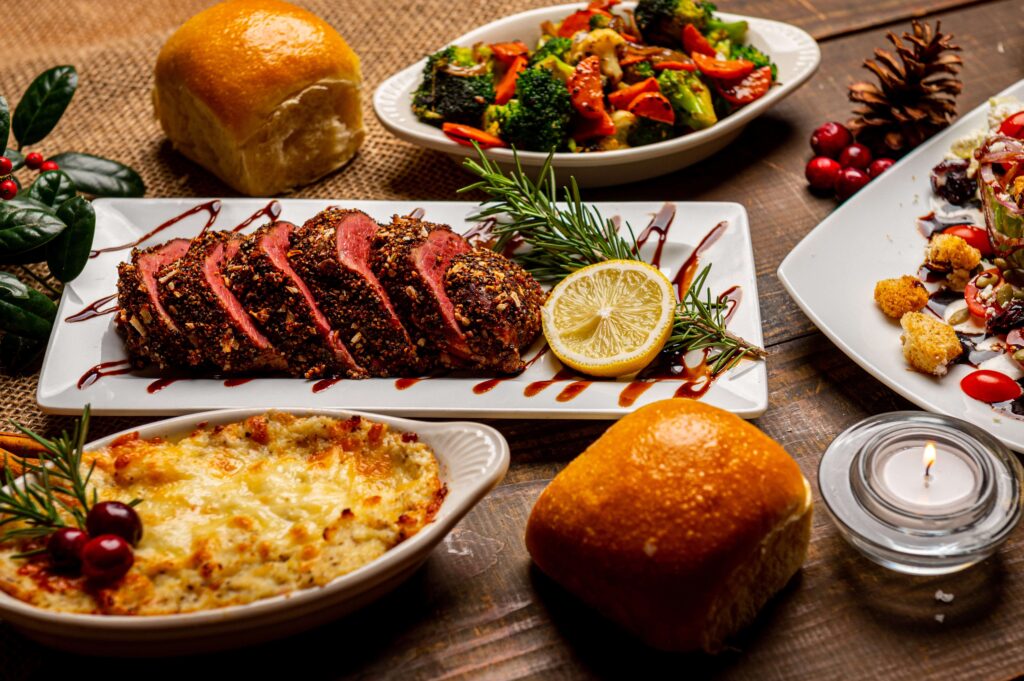
Most families in other countries, such as Spain, Sweden, Ireland, and others, celebrate Christmas on the morning of the 25th. In the Philippines, they celebrate straight after the Christmas Midnight Mass, which is another tradition of how Filipinos celebrate Christmas.
Filipino families celebrate a feast on Christmas Eve called Noche Buena. It’s the time of year when families cook their favorite dishes such as Lechon, Queso De Bola, spaghetti, Morcon, bacon, and fruit salad. You get to spend a lot of time and bond with your family and loved ones over a meal, in addition to filling your belly with delicious food.
5. Giving gifts

Filipinos enjoy exchanging gifts with their loved ones. Giving Christmas presents can be more fun when done with a sense of humor. Monito Monita is a term used to describe a sequence of gift exchanges between members of the family, friends, coworkers, and even classmates. It could happen on a daily, weekly, or monthly basis, based on what the group decides, and is an integral part of how Filipinos celebrate Christmas.
Each participant will pick the name of the individual who will receive their present at every gift-giving session. The name, however, must not be disclosed until the final day of gift-giving.
Christmas brings families, friends, and loved ones together. It is one of the most anticipated times of the year for children as they receive their gifts. They usually begin with the customary “mano,” which is a respectful gesture. After that, you’ll hear them exclaim, “Namamasko po.”
6. Putting up a belén
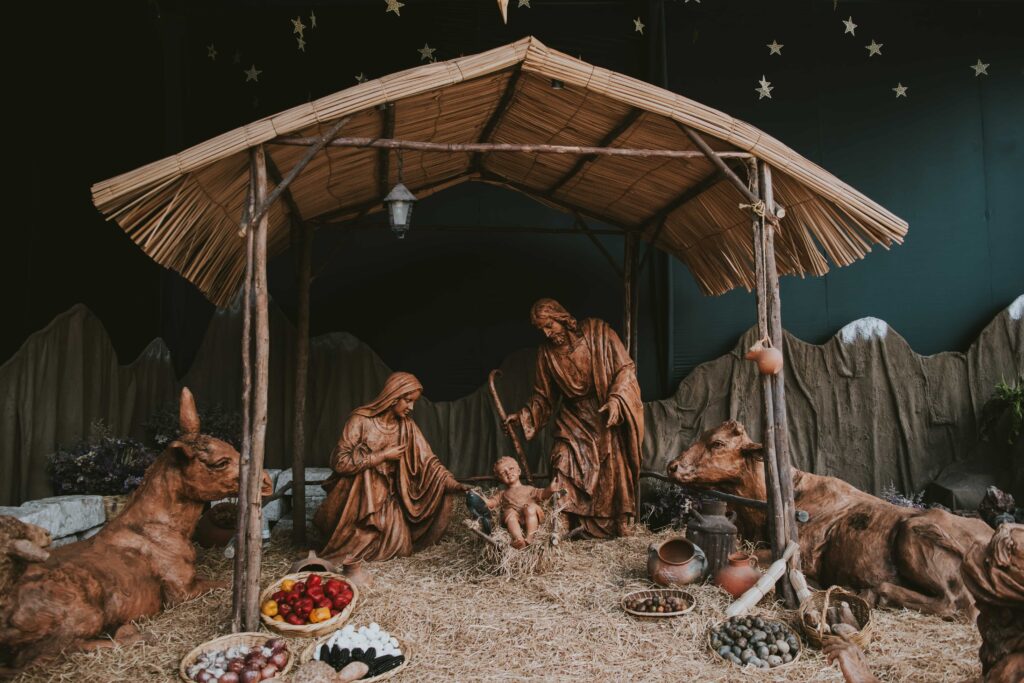
Another popular Filipino Christmas symbol is the belén.
The belén, or a tableau portraying the Nativity, can be found in Filipino homes, schools, as well as workplaces. It depicts the infant Jesus in a manger, surrounded by Mary, Joseph, the shepherds, and their flock, the Epiphany, and some barn animals, and is taken from the Spanish name for Bethlehem. There’s also the possibility of seeing an angel, a star, or both. In the Philippines, prizes are offered to the community’s best belén in various localities.
7. Aguinaldo
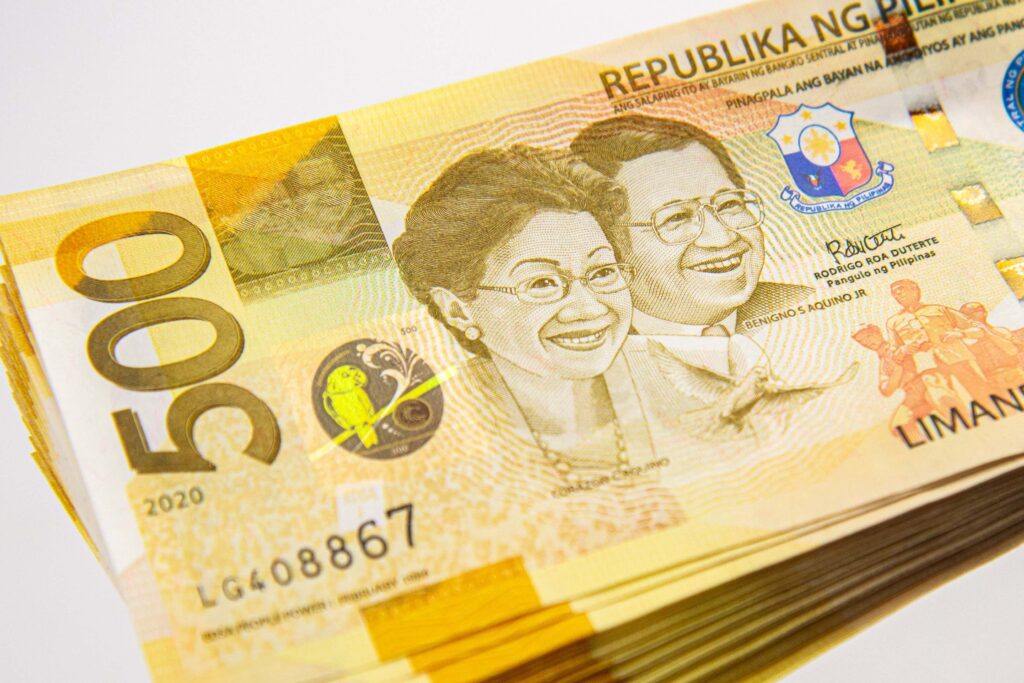
If you have children and plan to visit relatives in the Philippines over the holidays, this next Christmas custom will be a hit with the kids, but not so much with the adults. Filipinos respect closeness even among extended family members and place a high value on family. And Christmas is particularly beloved since it brings the entire family together.
Typically, the children form a line to execute pagmamano . This Filipino courtesy greeting entails holding the elder’s hand, bending slightly while touching the back of the hand to their forehead, and saying “mano po.” The elders then present crisp banknotes to the kids as “aguinaldo” (Spanish for “bonus”). Godparents are often expected to offer their godchildren more Aguinaldo.
The Aguinaldo is another traditional means of distributing gifts in the Philippines during the Christmas season. It might be viewed as a benefactor’s present or money. The most typical practice is for godparents to give presents or money to their children. Bonus is referred to as Aguinaldo in Spanish. Companies that give Christmas bonuses or gift packs containing food items to their staff are examples of Aguinaldo’s other methods.
8. Christmas parties
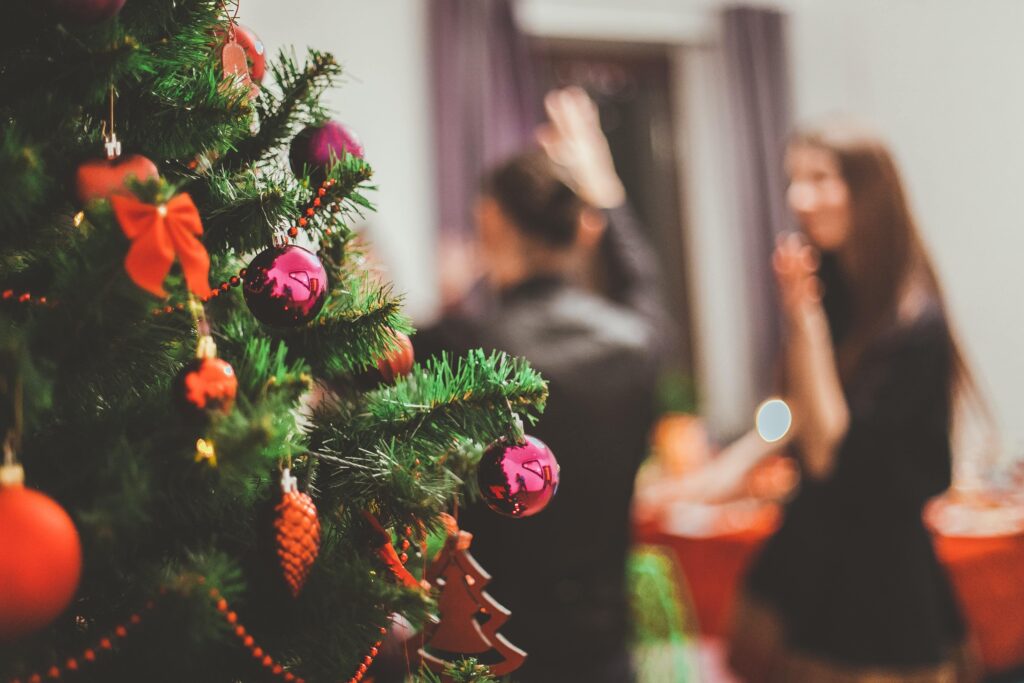
In the Philippines, having multiple Christmas parties is normal, even expected. There’s always the school Christmas party, the company Christmas party, the one with your closest buddies, the one with your high school mates, your university buddies, your relatives, your basketball team, and so on. This is a unique part of how Filipinos celebrate Christmas.
Because most of them are potlucks and most will feature some form of “Secret Santa” present exchange, they’ll be a bit of a splurge on the budget, but they’ll be a terrific build-up to the major event on Christmas Eve. Filipinos love them because they’re a great way to spend time with friends, have a good time, and eat a lot of food.

How Filipinos celebrate Christmas is a one-of-a-kind experience. Christmas is a season to celebrate family, friendships, and neighborhood, and this loving vibe seems to waft through the air, despite the abundance of presents and food.
Take advantage of this upbeat mood, which will linger into the fourth quarter of the year, and finish the year on a high note. Admire the parols that adorn every street, household, and neighborhood; listen to the street carolers’ singing and instruments, and open your heart to the joyous Filipinos who make their country among the most beautiful places in the world to fully embrace the holidays.
Subscribe to TrulyFilipino
Receive up-to-date news, dating tips, and more!

You May Also Like

The Do’s and Don’ts of First Dates With Filipinos

10 Signs Your Relationship Is Ready for Marriage

How To Look for Filipino Singles Online

Filipinas Kong Mahal
- Filipino Culture and Heritage
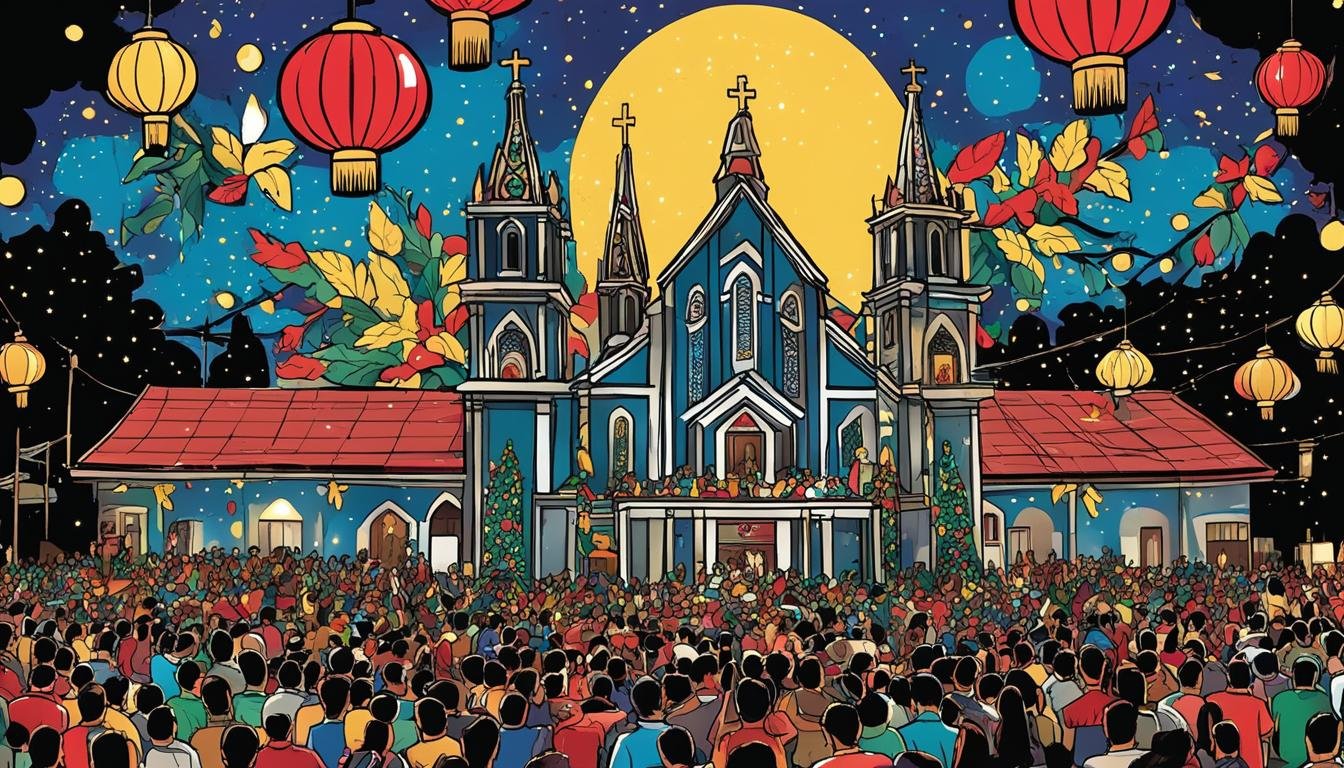
Simbang Gabi – A Guide to Filipino Christmas Tradition
by Historian · 14 January 2024
Simbang Gabi , also known as the “Misa de Gallo” or “Rooster’s Mass,” is a cherished Filipino Christmas tradition that holds a special place in the hearts of Filipinos. It is a series of dawn masses leading up to Christmas Eve, serving as a time of spiritual reflection, devotion, and celebration.
This comprehensive guide aims to provide you with insights into the origins, spiritual significance, and cultural aspects of Simbang Gabi . Explore the historical inception of this beautiful tradition and its connection to the Filipino identity. Discover how Filipinos embrace and celebrate Simbang Gabi , from the symbolic Parol lanterns to the culinary delights enjoyed during the nine-day festivities.
Simbang Gabi is not just a religious observance; it is a testament to the deep-rooted faith and the spirit of togetherness within Filipino communities. Join us on this journey as we delve into the rich heritage of Simbang Gabi and its enduring essence in Filipino Christmas traditions.
Key Takeaways:
- Simbang Gabi is a cherished Filipino Christmas tradition .
- Also known as the “Misa de Gallo” or “Rooster’s Mass.”
- Simbang Gabi is a series of dawn masses leading up to Christmas Eve.
- It has deep historical and spiritual significance.
- Simbang Gabi celebrates Filipino culture and fosters community bonds.
Embracing Simbang Gabi Origins and Spiritual Significance
Simbang Gabi, a beloved Filipino Christmas tradition , has a rich historical inception and holds deep spiritual significance. Understanding the origins of Simbang Gabi and its connection to the Filipino culture is essential for fully embracing this cherished tradition .
The Historical Inception of Simbang Gabi
The origins of Simbang Gabi can be traced back to 1587 in the Philippines. As the Mass celebrating the days leading up to Christmas became overcrowded, the prior of the San Agustin Acolman Convent sought permission from the pope to hold the Mass outdoors. This request was granted, and Simbang Gabi was born, becoming a spiritual tradition deeply ingrained in Filipino society.
Misa de Gallo: When the Rooster Crows
The name “Misa de Gallo,” which translates to “Mass of the rooster,” is synonymous with Simbang Gabi. This name stems from the fact that the novena Masses are traditionally celebrated at dawn, coinciding with the crowing of roosters. This early morning schedule allows worshippers to start their day by welcoming the light of Christ and to engage in a profound spiritual experience.
Simbang Gabi serves as a testament to the enduring faith and devotion of the Filipino people. Its historical inception and close association with the rooster’s crow at dawn make it a uniquely spiritual experience that celebrates the anticipation of the birth of Jesus Christ.
Celebrating Simbang Gabi: A Pillar of Filipino Faith
Simbang Gabi is not only a religious observance but also an integral part of Filipino culture. Filipinos celebrate Simbang Gabi with deep reverence and joy, recognizing its significance as a pillar of their faith. This cherished tradition holds a special place in the hearts of Filipinos, embodying the essence of their religious devotion and cultural heritage.
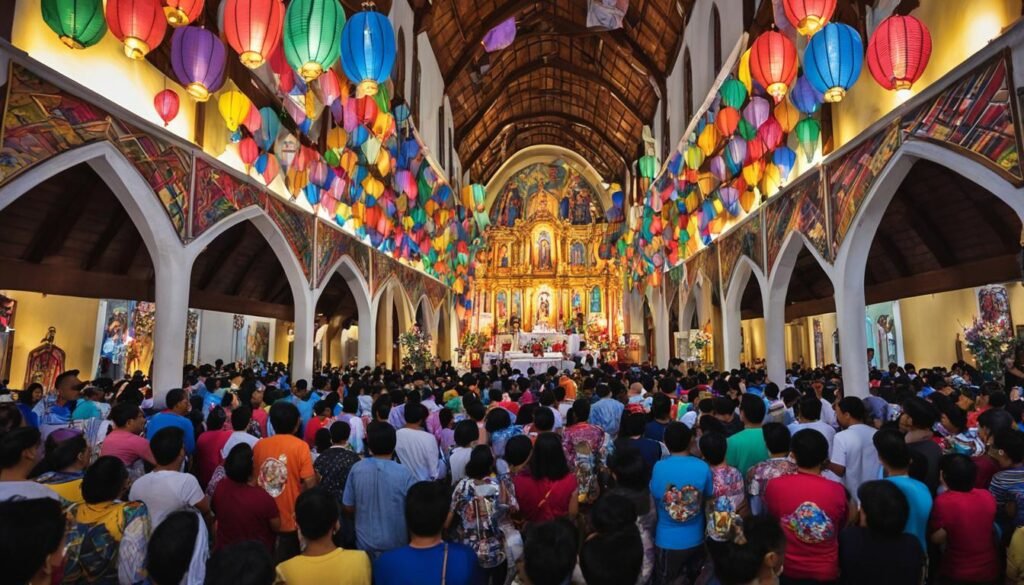
During the nine days leading up to Christmas, Filipino communities gather before dawn to attend the Simbang Gabi Masses. These early morning Masses signify the anticipation and preparation for the birth of Jesus Christ, reinforcing the spiritual connection between the Filipino people and their faith.
The celebration of Simbang Gabi is characterized by a sense of unity and communal spirit. Families and friends come together to attend Mass, offering prayers and expressing gratitude for the blessings bestowed upon them. This shared experience strengthens the bonds within the Filipino community , fostering a deeper sense of belonging and togetherness.
“Simbang Gabi allows us to celebrate our faith as a community , reminding us of the importance of our cultural heritage and the values that unite us.” – Maria Santos, a devout Filipino Catholic
The customs and traditions associated with Simbang Gabi further enhance its significance. Filipino communities decorate their churches with vibrant decorations and illuminate the surroundings with Parol lanterns , symbolizing the light of Christ illuminating their lives. After Mass, families indulge in traditional delicacies such as bibingka and puto bumbong , savoring the flavors that have been passed down through generations.
The celebration of Simbang Gabi in the Philippines reflects the resilience and unwavering faith of the Filipino people. It serves as a testament to their devotion and commitment to their religious beliefs, showcasing the cultural richness and diversity of the country.
Simbang Gabi is not just a series of Masses; it is a profound expression of Filipino identity and faith. It provides a sanctuary for spiritual reflection, an avenue for cultural preservation, and a source of strength and inspiration for the Filipino community. Celebrating Simbang Gabi is a time-honored tradition that continues to shape and define the Filipino faith , fostering a deep connection to God and a profound sense of pride in their heritage.
Parol Lanterns: Illuminating the Filipino Christmas Spirit
Parol lanterns hold a special place in the heart of every Filipino during the Simbang Gabi celebrations. These beautiful star-shaped lanterns symbolize the Filipino Christmas spirit , radiating warmth, joy, and hope. The sight of Parol lanterns adorning homes, churches, and streets instantly transports Filipinos into the festive holiday season.
The Symbolism of the Star Lantern
The Parol lantern is more than just a decorative item; it carries deep symbolism . The star-shaped design represents the Star of Bethlehem, which guided the Wise Men to the birthplace of Jesus. For Filipinos, it is a powerful reminder of the true meaning of Christmas, signifying the light that leads them to Christ. Just as the star guided the Wise Men, the Parol lantern guides Filipinos towards the celebration of Jesus’ birth.
Families Sharing the Light of Tradition
The making and displaying of Parol lanterns is a cherished tradition passed down through generations in Filipino families . The act of creating these lanterns brings family members together, fostering closeness and unity. Parents teach their children the intricate art of crafting Parol lanterns, instilling in them a sense of pride and reverence for their cultural heritage.
During Simbang Gabi, families gather to hang their beautifully crafted Parol lanterns, illuminating their homes with the spirit of Christmas. The soft glow emanating from these lanterns not only lights up the physical space but also ignites the hearts of family members, strengthening their bond and creating lasting memories. The Parol lanterns serve as a beacon of love, warmth, and togetherness, reminding families of the importance of unity and faith.
The Parol lanterns truly capture the essence of the Filipino Christmas spirit , combining tradition, symbolism , and the love of family. Their radiant glow serves as a reminder of the true meaning of Christmas, guiding Filipinos towards a celebration infused with faith, joy, and unity.
Festive Eats and Midnight Treats: The Culinary Delights of Simbang Gabi
Simbang Gabi is not only a spiritual journey but also a time for indulging in culinary delights. Throughout the nine-day celebration, Filipino delicacies take center stage, transforming every post-Mass gathering into a feast fit for the season.
Bibingka and Puto Bumbong: Iconic Simbang Gabi Delicacies
Two iconic delicacies are closely associated with Simbang Gabi: bibingka and puto bumbong . These mouthwatering treats have become synonymous with the Christmas season in the Philippines.
Bibingka is a fluffy rice cake made with glutinous rice flour, coconut milk, and eggs. It is traditionally cooked in clay pots lined with banana leaves, then topped with butter or margarine, grated coconut, and salted eggs. The result is a warm and fragrant treat that perfectly complements the chilly December mornings.
Puto bumbong , on the other hand, is a purple-colored sticky rice cake steamed in bamboo tubes. The mixture is made from glutinous rice flour called “pirurutong,” mixed with water, and then steamed until soft and chewy. It is served hot, generously brushed with butter or margarine, sprinkled with sugar, and topped with grated coconut. This traditional delicacy is a unique and flavorful addition to the Simbang Gabi feast.
The Joy of Post-Mass Gatherings and Shared Meals
After attending Mass, families and friends come together to enjoy the fruits of their labor in the kitchen. The aroma of freshly cooked bibingka and puto bumbong fills the air as loved ones gather around the dining table, eagerly savoring these delectable treats.
Post-Mass gatherings not only fill the stomach but also warm the heart as they foster a sense of togetherness and community. It is a time to share stories, laughter, and traditional dishes, strengthening the bonds between family members and friends.
As the sun rises and Simbang Gabi comes to an end, these culinary delights leave a lasting impression on the taste buds, a reminder of the joy and festive spirit that surrounds this cherished Filipino tradition.
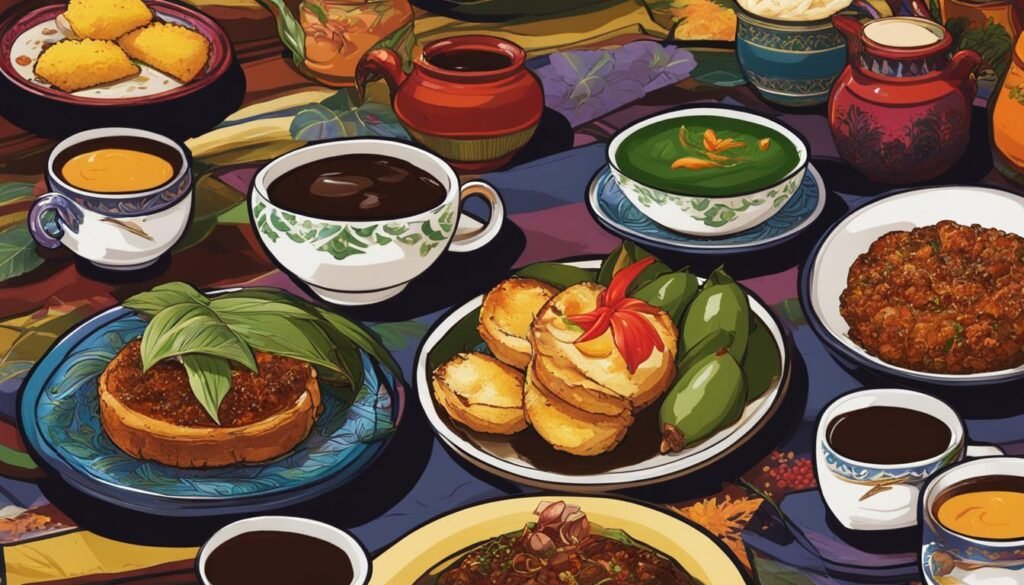
The Nine Nights of Mass: A Testimony of Devotion
Simbang Gabi is a sacred tradition that spans nine consecutive nights of Mass, signifying a profound testimony of devotion among Filipino Catholics. During these nine nights, believers gather before dawn to attend Mass, immersing themselves in prayer, reflection, and worship. This period is known as the novena, a period of intense spiritual preparation leading up to the celebration of Christmas.
The practice of attending Mass for nine consecutive nights holds great significance within the Simbang Gabi tradition. It is believed that by faithfully completing the novena, individuals receive abundant blessings, graces, and spiritual fortitude. The commitment to attending Mass each morning demonstrates a deep sense of devotion and serves as an expression of faith.
Furthermore, participating in the nine nights of Mass allows individuals to deepen their spiritual connection and draw closer to God during the Advent season. It provides a dedicated time for introspection, repentance, and renewal of one’s commitment to the Christian faith. The collective gathering of the faithful in the early morning hours creates a powerful atmosphere of communal devotion and strengthens the bond of shared faith.
The decision to attend Mass for nine consecutive nights requires dedication and sacrifice, as it often means waking up early, braving the dark, and facing the challenges of scheduling everyday responsibilities. However, the rewards experienced during the Simbang Gabi period are immeasurable, as they encompass not only spiritual fulfillment but also a deep sense of community and belonging.
By actively participating in the nine nights of Mass , individuals cultivate a sense of discipline, perseverance, and spiritual growth. The commitment to this tradition strengthens their relationship with God and nourishes their faith, fostering a deeper understanding of the true meaning of Christmas.
Simbang Gabi serves as a testimony to the enduring devotion and unwavering faith of Filipino Catholics. It reminds them of the importance of prioritizing their relationship with God and experiencing the joy of community worship. The nine nights of Mass truly exemplify the profound devotion and spirituality of Simbang Gabi, making it a cherished tradition that continues to inspire and uplift the Filipino faithful.
Simbang Gabi in the Philippines vs. The Diaspora
The adaptation of simbang gabi in overseas filipino communities.
Simbang Gabi, the beloved Filipino Christmas tradition, extends beyond the borders of the Philippines and finds its place in overseas Filipino communities. While the essence remains the same, Simbang Gabi has undergone adaptations in these diaspora settings, reflecting the unique cultural context and experiences of Filipinos living abroad.
Overseas Filipino communities have successfully preserved Simbang Gabi, ensuring that the tradition thrives and remains an important cultural practice. Despite being away from their homeland, Filipinos continue to celebrate Simbang Gabi with enthusiasm, deepening their connection to their roots and creating a sense of belonging.
In these communities, Simbang Gabi often takes on a more compact format. Due to various constraints such as work and other responsibilities, the nine consecutive dawn Masses may be condensed into a weekend or fewer days. This adaptation allows for greater participation and ensures that the essence of Simbang Gabi is still upheld.

Cross-Cultural Celebrations: A Bond Across Borders
Simbang Gabi in overseas Filipino communities also showcases the power of cross-cultural celebrations . This tradition serves as a unifying force, not only among Filipinos but also between different cultures and communities. It becomes an opportunity for exchange, understanding, and appreciation of diverse traditions.
During Simbang Gabi, it is common to witness people from different backgrounds come together to experience the beauty of Filipino culture and spirituality. This intercultural exchange promotes harmony, fostering a sense of unity and strengthening the bonds between communities.
Simbang Gabi in the diaspora is a testament to the resilience of Filipino traditions and their ability to adapt and continue flourishing even outside the home country. It is a celebration that transcends borders, bringing people together, and serving as a reminder of the rich cultural heritage that connects overseas Filipino communities to their roots.
Simbang Gabi: A Quintessential Advent Experience
Simbang Gabi holds a significant place in the Filipino Catholic tradition, making it a quintessential Advent experience . This section explores the connection between Simbang Gabi and the Advent season, highlighting how it serves as a spiritual preparation for the celebration of Christmas. As Filipinos gather before dawn to attend Mass for nine consecutive days, they engage in a deep reflection on the significance of Christ’s birth and the coming of the Savior.
The spiritual preparation of Simbang Gabi aligns perfectly with the essence of the Advent season. Advent, derived from the Latin word “adventus” meaning “coming,” symbolizes the anticipation of Jesus’ birth and the second coming. It is a time of joyful longing and expectant hope, allowing believers to prepare their hearts and minds to welcome the Messiah.
Simbang Gabi creates a space for individuals to engage in a dedicated period of prayer, self-reflection, and repentance. It offers an opportunity to rekindle one’s faith and renew their commitment to live a life guided by the teachings of Christ.
The early morning Masses of Simbang Gabi serve as a reminder of the shepherds’ vigil in the fields, waiting for the good news of Jesus’ birth. Just as the shepherds kept watch overnight, the faithful gather in the darkness of dawn, eagerly anticipating the light of the world, Jesus Christ. This unique aspect of Simbang Gabi deepens the spiritual experience, allowing participants to connect with the story of Christ’s birth in a profound and personal way.
The devotion and discipline demonstrated in attending Simbang Gabi reflect the Filipino’s unwavering faith and commitment to their spiritual journey. By sacrificing sleep and starting their day in prayer, Filipinos actively participate in the Advent season, immersing themselves in the anticipation of Christmas.
Simbang Gabi – An Interweaving of Culture and Faith
Simbang Gabi, the cherished Filipino Christmas tradition, beautifully intertwines culture and faith , serving as a means to sustain heritage and foster community bonds. The celebration of Simbang Gabi nurtures Filipino culture by preserving traditions that have been passed down through generations. It is a testament to the deep-rooted connection between faith and the Filipino identity, reinforcing the collective spirit of the community.
Sustaining Heritage Through the Celebration of Mass
Simbang Gabi plays a pivotal role in sustaining Filipino heritage by keeping age-old traditions alive. The nine consecutive nights of Mass during Simbang Gabi provide an opportunity for individuals to reconnect with their cultural roots and strengthen their sense of identity. Through the celebration of Mass, Filipinos honor their ancestors, carry forward their customs, and uphold the values that define their unique heritage.
Nurturing Community and Building Bonds During the Holidays
Simbang Gabi is not just a religious observance; it is a time of joyful community gatherings and shared experiences. As Filipinos gather in churches before dawn to attend Mass, they come together as a united community. The bonds formed during Simbang Gabi extend beyond the walls of the church, with families, friends, and neighbors joining in festivities, sharing meals, and creating lasting memories. Simbang Gabi strengthens the fabric of the community, fostering a sense of belonging and togetherness during the holiday season.
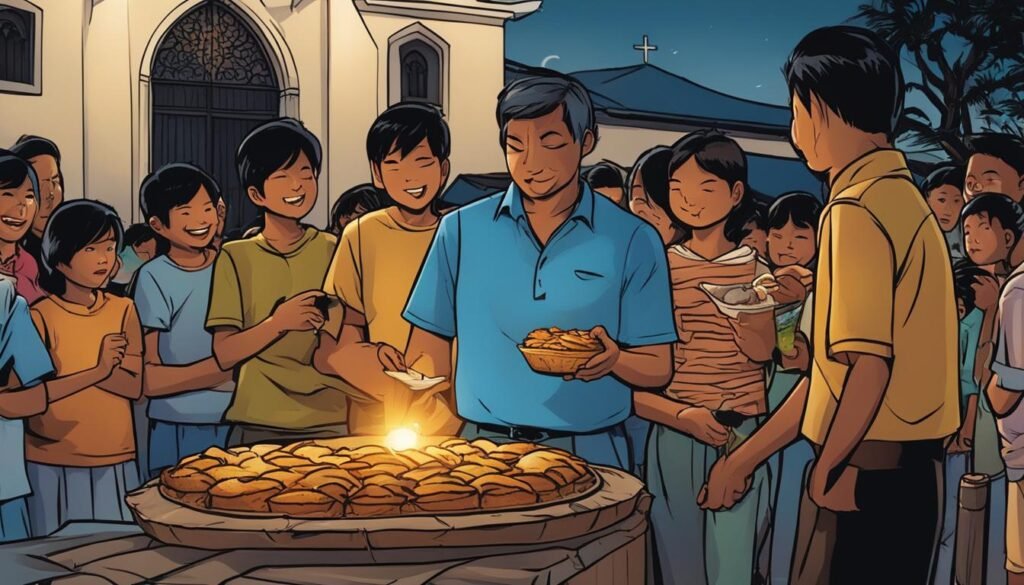
Preserving Simbang Gabi for Future Generations
As we conclude this comprehensive guide to Simbang Gabi , it is crucial to acknowledge the significance of preserving this cherished Filipino Christmas tradition for future generations . Simbang Gabi stands as a testament to the enduring essence of Filipino Christmas traditions , encompassing both culture and faith . To ensure its longevity, it is essential to pass down the traditions, customs, and values associated with Simbang Gabi.
Reflections on the Enduring Essence of Filipino Christmas Traditions
Simbang Gabi holds a special place in the hearts of Filipinos, intertwining culture and faith in a beautiful and meaningful way. This enduring essence of Filipino Christmas traditions reflects the deep-rooted love for community, the importance of togetherness, and the spiritual preparation for the celebration of Christmas. By embracing Simbang Gabi and transmitting it to future generations , we honor our heritage and fortify the bonds that make us proud of our Filipino identity.
Simbang Gabi is not just a series of dawn Masses or a cultural tradition—it is a spiritual legacy that has been passed down for centuries. By preserving Simbang Gabi , we ensure that this rich and vibrant tradition continues to inspire and bring joy to countless individuals. So let us unite in our dedication to preserving Simbang Gabi , allowing future generations to experience the profound beauty and meaning it holds for our Filipino Christmas celebrations.
What is Simbang Gabi?
Simbang Gabi is a cherished Filipino Christmas tradition that involves attending a series of dawn masses leading up to Christmas Eve. It is also known as the “Misa de Gallo” or “Rooster’s Mass.”
When did Simbang Gabi originate?
Simbang Gabi originated in 1587 in the Philippines when the crowds at the Mass on the days before Christmas overflowed from the church. The prior of the San Agustin Acolman Convent requested permission from the pope to hold the services outdoors, and thus Simbang Gabi became a Filipino spiritual tradition.
Why is Simbang Gabi called “Misa de Gallo”?
Simbang Gabi is also called “Misa de Gallo” because the novena Masses are celebrated at dawn when roosters crow. The term “Misa de Gallo” translates to “Mass of the rooster.”
How do Filipinos celebrate Simbang Gabi?
Filipinos celebrate Simbang Gabi by attending the early morning Masses, participating in parades and processions, and engaging in various cultural traditions and customs such as the display of Parol lanterns and indulging in traditional delicacies.
What is the significance of Parol lanterns in Simbang Gabi celebrations?
Parol lanterns play a significant role in Simbang Gabi celebrations as they symbolize the Filipino Christmas spirit . These star lanterns represent the guiding light of the Star of Bethlehem and are often made and displayed by families to signify the sharing of tradition and the joy of the holiday season.
What are some traditional delicacies enjoyed during Simbang Gabi?
Some traditional delicacies enjoyed during Simbang Gabi include bibingka and puto bumbong, which are rice cakes. These delicacies are often sold outside churches after the Masses, and it has become a custom for families to share these treats and gather for meals after attending the early morning Mass.
Why is attending Mass for nine nights significant during Simbang Gabi?
Attending Mass for nine consecutive nights during Simbang Gabi is considered a testimony of devotion. It is believed that completing the full novena brings blessings and strengthens one’s faith, making it a spiritually significant practice.
Is Simbang Gabi celebrated only in the Philippines?
No, Simbang Gabi is not only celebrated in the Philippines but also in overseas Filipino communities. While there may be some adaptations and differences between the celebrations in the Philippines and the diaspora, the essence and cultural significance of Simbang Gabi remain intact across borders.
How does Simbang Gabi relate to the Advent season?
Simbang Gabi serves as a spiritual preparation for the celebration of Christmas, making it a quintessential Advent experience in the Filipino Catholic tradition. It embodies the anticipation and reflection associated with Advent, deepening one’s faith in preparation for the birth of Jesus.
How does Simbang Gabi contribute to Filipino culture and community bonds?
Simbang Gabi nurtures Filipino culture by sustaining traditions, preserving heritage, and reinforcing a sense of community. The celebration of Simbang Gabi brings families and communities together, creating stronger bonds through shared devotion, festivities, and cultural practices during the holiday season.
Source Links
- https://uscatholic.org/articles/202012/the-christmas-tradition-of-simbang-gabi/
- https://cebudailynews.inquirer.net/543364/exploring-simbang-gabi-a-dive-into-filipino-christmas-tradition
- https://dcgary.org/news/filipino-families-mark-christmas-traditions-simbang-gabi-mass
You may also like...

From Colonies to Assemblies: The Political Evolution of the Philippines
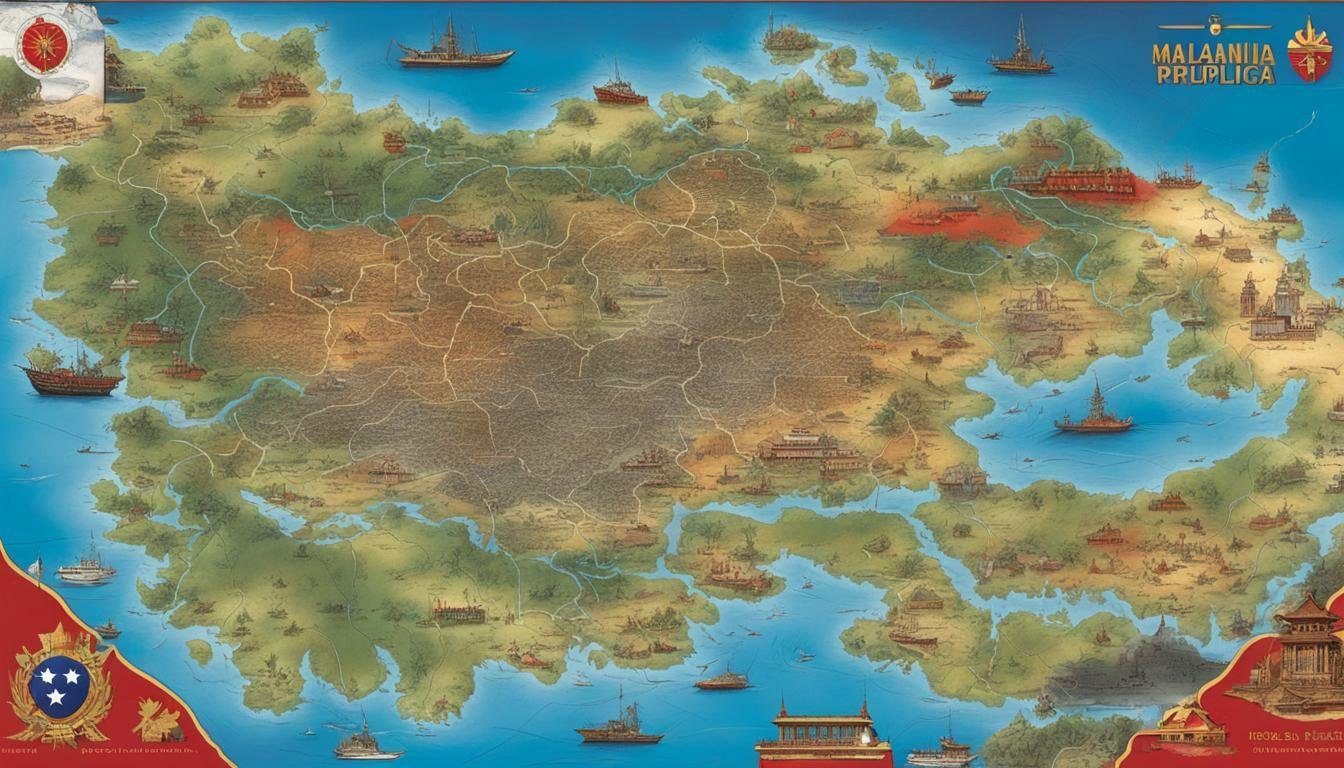
The Philippine-American War: Forgotten Struggles, Enduring Impact

Manila’s Role as Capital
- Next story The Resistance Against the Spread of Christianity in the Philippines
- Previous story The Complex and Diverse Pre-colonial Philippines Before Spanish Arrival

- President of the Philippines
Manuel L. Quezon: The 2nd President of the Philippines
14 March 2024

Bongbong Marcos: The 17th President of the Philippines

Rodrigo Duterte: The 16th President of the Philippines

Benigno Aquino III: The 15th President of the Philippines
- Recent Posts
- Popular Posts
- Recent Comments

Gloria Macapagal Arroyo: The 14th President of the Philippines

Explore Hinilawod: Discover an Epic Tale of Filipino Heritage
21 September 2023
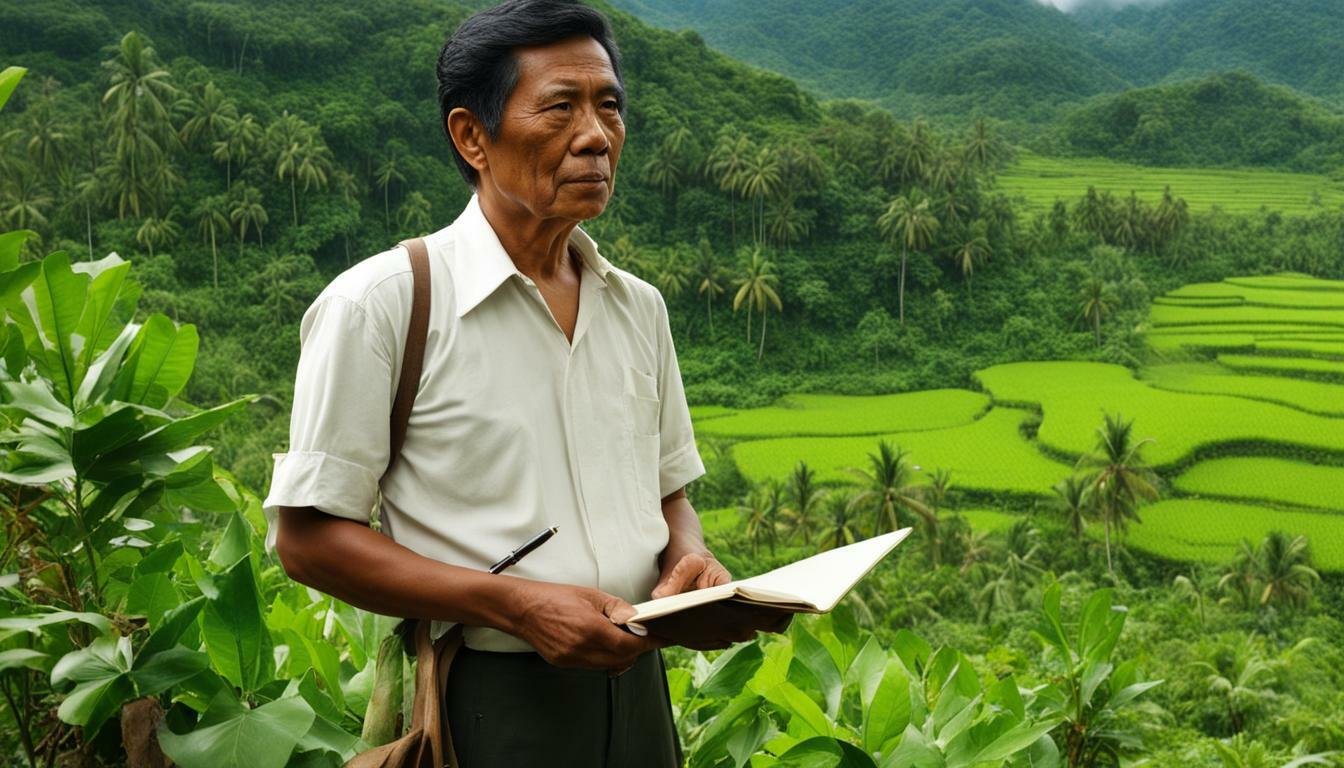
- Contemporary Period (1986-Present)
Exploring the Life and Legacy of Isabelo de los Reyes
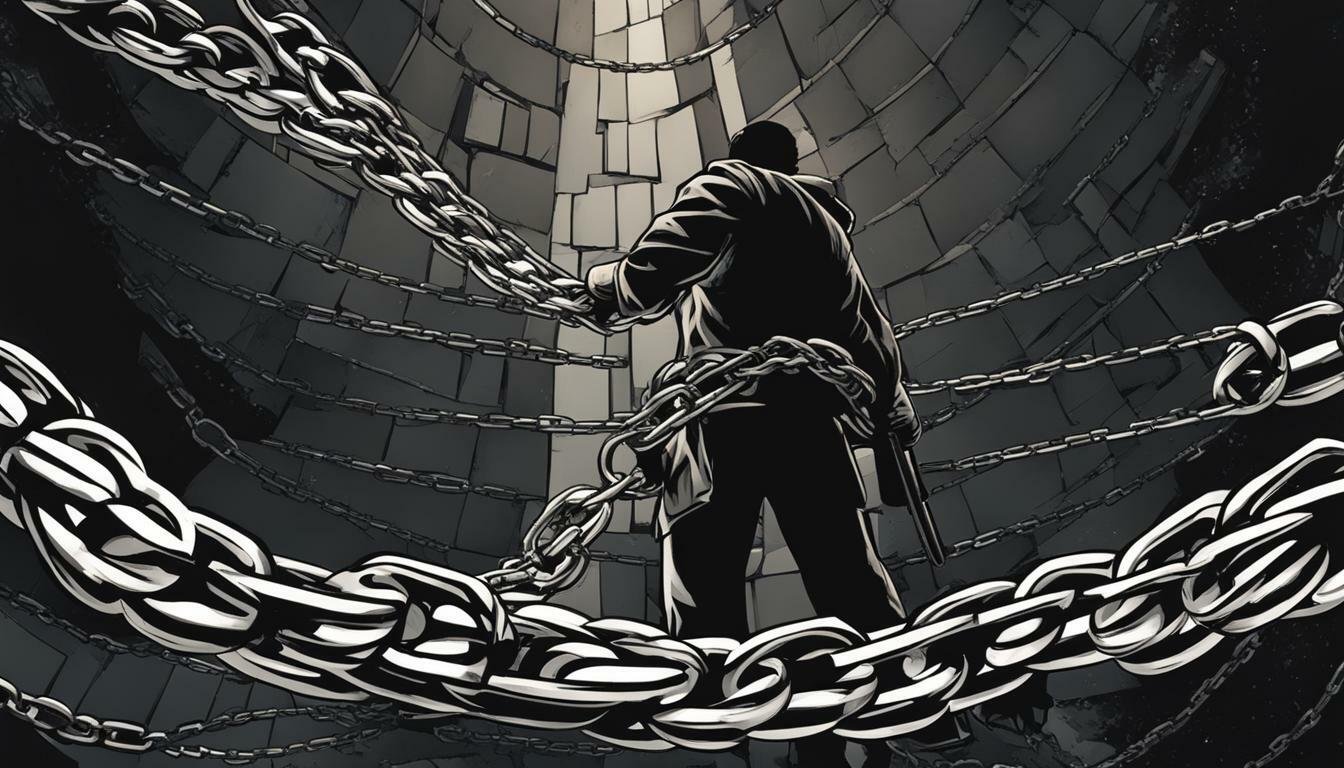
Understanding Alipin Mentality

The Political and Economic Turmoil in the Philippines After Marcos Regime
- creatures of the soil Datu (Lord) Filipino Language Heritage kingdom of cebu kingdom of luzon Laws Place president Principality of Mactan raja (king) raja(king)
- American Colonial Period (1901-1946)
- Ancient Monarchs and Leaders in the Philippines
- Martial Law and Fourth Republic (1972-1986)
- Philippine mythological creatures
- Post-War Era and Third Republic (1946-1972)
- Pre-Colonial (900–1560)
- Spanish Colonial Period (1521-1898)

Christmas in the Philippines: 10 Unique Filipino Christmas Traditions
by Leslie | Dec 22, 2020 | Blog | 11 comments
Perhaps there’s really no other country in the world that celebrates Christmas the way we d0 – Christmas in the Philippines is splendid.
On this blog, learn the “Filipino way” of celebrating Christmas and get to know 10 Filipino Christmas traditions that are unique in the Philippines. Gain insights at why Christmas looks and feels a lot different in our country than in the rest of the world. We also highlighted some Philippine destinations you might want to consider for a Christmas vacation.
Christmas in the Philippines Amidst Crises
The Philippines may have experienced the worst calamities and pandemic in 2020, but we also witnessed the best signs and gestures of hope this year.

Kids holding Parol in a market in Philippines | Photo by: Kobby Dagan | Shutterstock Photo ID: 1598479792
Despite crises and losses, Filipinos will always have the heart to celebrate Christmas. After all, i sn’t the birth of our Saviour Jesus Christ enough reason to celebrate?
For Filipinos, life goes on and so does Christmas. It may look a bit different this year, but its meaning will always stay the same.
How Do Filipinos Celebrate Christmas?
The thought and feel of Christmas bring great excitement to most Filipinos.
Christmas in the Philippines starts early and ends late – that is, beginning -ber months (SeptemBER until DecemBER) and extends until the Feast of the Three Kings in January. Here, a month of celebration is never enough. Thus, we extended it for as long as 5 merry months. Surely, Christmas is definitely “more fun in the Philippines” – the country with the longest celebration of Christmas.

Cheerful kids wanting to complete the 9-day Simbang Gabi for a special Christmas wish
2) Classic Christmas Foods in the Philippines
There are seasonal Filipino delicacies that are not typically found all year-round but are mostly served during the Christmas season. These classic Christmas favorites are often sold outside churches providing easy access for people who attended the Simbang Gabi.
Classic Christmas foods include:
Bibingka is a type of rice cake cooked using clay pots with banana leaf lining which is then heated by charcoal fire at the top and bottom. It rich produces flavorful taste quite similar to a rice pudding but a bit saltier because of the salted egg and grated cheese that add up to its distinct taste.
Puto Bumbong
Puto Bumbong is a steamed rice cake cooked using a bamboo tube. Its color is purple, wrapped in banana leaf and is topped with a combination of equally flavorful Filipino ingredients such as margarine, muscovado sugar and freshly grated coconut. This food is so special that even the thought of it would actually make you feel like Christmas.

Parol, Filipino Christmas Lantern | Photo by: Wuttichai jantarak | Shutterstock Photo ID: 490206430
Parol is the local term for lantern. It is a star-shaped lantern which is the iconic symbol of Christmas in the Philippines. It is typically being hanged outside Filipino houses which symbolizes light (hope) similar to the star of Bethlehem which guided the three kings to the manger.
Parol comes in different shapes, sizes and colors. It can be as simple as a bamboo covered colored paper, it can be made from recycled plastic bottles shaped into a star or it can be as intricate as capiz with pre-programmed LED lights. No matter what the design is, it all means the same. It symbolizes hope for Filipinos.
If you want to see a good collection of Parols, then you might want to head on to Pampanga – “The Lantern Capital of the Philippines”.
4) Filipino Christmas Decorations
For Filipinos, putting up colorful Christmas decors is a family tradition that every child and child-at-heart look forward to. Such Christmas ornaments add up to the overall joyful feeling at home. It is even made more special when every member of the family helps in decorating the Christmas tree.
Aside from Parol, other popular Filipino Christmas decors include:
Christmas tree (made from indigenous or plastic materials)
Christmas lights, christmas bling-blings (like christmas balls, candy cane, etc), belen (filipino version of nativity scene), santa claus (socks or santa figures).
Of course, no Christmas is complete without Santa Claus – the Father of Christmas. The magical character will continue to be part of our Christmas tradition now and always. Ho-ho-ho!


5) Monito Monita and Christmas Parties
Filipinos love Christmas parties. It is a special occasion that Filipinos look forward to – whether in school, at the office, at home or in other organizations. It is one of the most-awaited gatherings of the year where Filipinos prepare good food, wear their best outfit, showcase their talents for an intermission number, play lots of fun games with exciting prizes and do exchanging of gifts.
Monito Monita is the Filipino version of exchanging gifts which is usually done at Christmas parties among families, friends, colleagues, schools etc.
Here, every participant will randomly pick a name in advance (usually thorough draw lots) of a person he/she will give her gift to. The name of the person whom you picked shall remain a secret until the day of the party.
These days, because of Filipinos’ creativity and playfulness, some would even assign themes for choosing gifts – something like, choose gifts that are “naughty”, “shining shimmering splendid” or any random theme the group has agreed on.

Parol-maker and a display of his products | Photo by: Kobby Dagan | Shutterstock Photo ID: 1640017111
As you may have already known, lanterns or Parol is an iconic symbol of Christmas in the Philippines. Tourists who come to witness the lantern festival are on a real treat, definitely a must-see feast for the eyes. They often bring home a Parol as a perfect Christmas souvenir too.
Christmas Vacation: Best Place to go in Philippines During December
Without the pandemic and travel restrictions, the following destinations would have been the top-notch choices for a Christmas vacation in the Philippines. With a good combination of relaxing ambiance, rich culture and excellent opportunities for nature as well as sightseeing tours, these are the top 3 places we can recommend (with sample itineraries on the link):
Cebu & the Visayas
It’s Always a Merry Christmas in Philippines
Almost always, most Filipinos would smile at the thought of Christmas. Seasons may have changed and circumstances can become very difficult at times, but Christmas will always be the best part of our year. It has the power to spark hope and love and joy.
Certainly, Filipinos know how to see the light in Christmas.
Philippine Tour: Planning to Spend a Christmas Vacation in Philippines?
2020 year may not be the best year for traveling but better days will come. Who knows, next year might be the perfect timing to have that long-overdue Philippine Christmas vacation that you deserve.
We customize in creating the best Philippine tour. Let us know if you’ll be interested to experience an epic Christmas vacation in the Philippines – we can certainly help. Feel free to contact us. 🙂
We wish you a blessed Christmas!
11 Comments
Hello, Good afternoon!
I’ve found this blog when we we’re searching about the Christmas in the Philippines. While i was reading the Blog the number 8 was the best one. It’s true in Philippines when September starts you will hear Jose Mari Chan’s Song. You will usually heard it in radios. This blog is really accurate especially in number 8.
I’ve found this blog when we we’re searching about the Christmas in the Philippines. While i was reading the Blog the number 8 was the best one. It’s true in Philippines when September starts you will hear Jose Mari Chan’s Song. You will usually heard it in radios. This blog is really accurate especially the number 8. It’s funny because it was true that Jose Mari Chan’s song is in everywhere.
Here in the Philippines, for Filipinos Christmas is one of the most important holidays. Filipinos love to celebrate Christmas with family, relatives, and friends. It is the time of the year when Filipino families usually reunite and do things together with much fun, vigour, and festivities. Christmas is also a beautiful time of giving. It is when families and friends come together and give gifts to one another to celebrate their love for each other. There are not many better feelings in the world than when a loved one opens the gift you gave them and smiles.That is why Christmas is the best holiday. Also, Filipinos welcome the season uniquely with different flavors and traditions that make Christmas extra special. And one of the most tradition that they do is the midnight mass or Simbang Gabi or Misa de Gallo – one of the practices most commonly observed during the season. Most people believe that a wish may be granted to those that will complete all nine masses.Christmas is celebrated to remember the birth of Jesus Christ, who Christians believe is the Son of God. It is a season of joy, of peace, of great tidings. A season when we celebrate the birth of Christ the King, the redeemer of mankind. Jesus is the reason for the season. That’s why Christmas is the best season and best holiday for welcoming our Christ the King.
Christmas in the Philippines are a combination of western and native Filipino traditions. many of us stay up all night into Christmas day! During December 24 evening, Christians attend church to listen to the last ‘simbang gabi’ or the December 24 mass. this can be followed by a midnight feast, called Noche Buena. Noche Buena is a time for family and friends to gather and eat, drink, be merry, and for some, celebrate the religious component of the holiday, the birth of Jesus. It’s an anticipatory celebration where families gather to eat and often exchange gifts. Meanwhile, Christmas day itself is more relaxing. Filipinos welcome the season uniquely with different flavors and traditions that make Christmas exceptional. The Filipino’s strong sense of family and preserving ties make Christmas the right time to share love and blessings with one another. Christmas within the Philippines is all about families. For Filipinos, Christmas is one among the foremost important holidays. Filipinos like to celebrate Christmas with family, relatives, and friends. For our family Christmas is also a celebration of Christ’s birth and God’s unspeakable gift to the world. And that celebration helps to shape the traditions that keep our family connected in a special way during this season of joy. It is always a wonderful time that brings our family together as we reach out to others. it’s the time of the year when Filipino families usually reunite and do things along with much fun, and festivities.
Christmas Eve is the time wherein Filipino citizens are very happy, why? It is simply because of our culture. Filipino culture has the longest Christmas celebration and it comes with days full of blessings and happiness because it is the birth of our Savior Jesus Christ. Individuals and families exchanged gifts, prepare feast, and of course earned new memories. Filipino’s believed that when you successfully attended the days of the “Simbang gabi” one of your wish will come true. On the other hand, during the thanks giving, kids are asking for gifts to their ninong and ninang. And lastly, the most important part is celebrating is decorating the Christmas tree with your family, making Christmas Parol out of recycled materials, and my favorite part of the celebration is Christmas meal. The memories is indeed very important to us, just spread love. Time is gold! every moment is important therefore, be happy and contented even in small things. That’s how our Filipino culture works.
Filipinos celebrate Christmas in their own special way, with a variety of cuisines and customs that make the holiday more special. … Because of the Filipinos’ strong sense of family and commitment to maintaining links, Christmas is the ideal time to share love and blessings with one another. In the Philippines, Christmas is all about family.
Many people stay up all night on Christmas Eve and Christmas Day! Christians went to church on Christmas Eve evening to hear the final’simbang gabi,’ or Christmas Eve mass. After that, there is a midnight feast known as Noche Buena.
Filipinos welcome the season uniquely with different flavors and traditions that make Christmas extra special. The Filipino’s strong sense of family and preserving ties make Christmas the perfect time to share love and blessings with each other. Christmas in the Philippines is all about families. Christmas customs in the Philippines are a mixture of western and native Filipino traditions. … Many people stay awake all night into Christmas day! During Christmas Eve evening, Christians go to church to hear the last ‘simbang gabi’ or the Christmas Eve mass. This is followed by a midnight feast, called Noche Buena.Unlike Christmas in most Western countries, the Filipino Christmas is more centered on Jesus than on Santa Claus. In fact, they have Misa de Gallo, a nine day-long series of masses that commence on Christmas eve. A Christmas nativity scene decoration is also common in Filipino households.
In most countries, nativity scenes – also known as the belen – are only set up in churches or other religious spaces. But in the Philippines, it’s common to find it everywhere. In fact, every Filipino household will have one set up during the festive season.
A complete set is comprised of baby Jesus, Mary, Joseph, the Three Kings, as well as every barn animal you can think of, but many belens exclude the last two since they’re not as essential. Whether it’s made of the original porcelain or recycled materials, you’ll see one in schools, building lobbies, and homes. Some schools and barangays even hold competitions for the best belen, making for some lavish displays.Everyone knows about Christmas lights, but the Philippines has the parol, a Christmas ornament unique to us. Traditionally, parols come in the shape of a big circle with a star in the middle, but you can also choose from various designs like stars and flowers. It can also be made from different materials like plastic, wire, wood, or even recyclable materials. The parol was originally made to hang on lamp posts to guide mass-goers to Simbang Gabi, but now they can be found everywhere like outside houses, in malls, and officesSimbang Gabi means “night mass”, which is basically what it is. Filipinos attend mass either late at night or in the wee hours of the morning for all 9 days before Christmas. We try to complete all 9 days, both as a religious practice and because of the belief that attending all 9 masses will grant you a wish.To go with the season, churches are decorated to add a Christmas flair, and vendors often sell local Christmas goods like bibingka and puto bumbong outside after the mass.
Filipinos celebrate Christmas in their own unique style, with a wide range of dishes and customs that add to the festive atmosphere. Christmas is a perfect time to give love blessings with one another because of the Filipinos’ strong sense of family and devotion to keeping relationships. Christmas in the Philippines is an annual festival celebrating the birth of Jesus Christ, which is celebrated by billions of people around the world on December 25 as a religious and cultural event. Christmas in the Philippines is more about Jesus than Santa Claus. They even have Misa de Gallo, which is a nine-day series of masses that begins on Christmas Eve. In Filipino homes, a nativity scene is also a popular Christmas decoration.
People in the Philippines like to celebrate Christmas for as long as possible! The playing of Christmas carols in shops can start in September! The formal Christmas celebrations start on 16th December when many people go the the first of nine pre-dawn or early morning masses. The last mass is on Christmas day. The Christmas celebrations continue to the First Sunday in January when Epiphany or the Feast of the Three Kings is celebrated. Most Filipinos are Christians with about 80% of people being Catholics. It’s the only Asian country with so many Christians. Because of this, Christmas is the most important holiday in the Philippines. December is actually one of the ‘cooler’ months of the year in the Philippines. The Philippines only has two real seasons, wet (June to October) and dry (April and May). December is one of the months in between the wet and dry seasons.
May I suggest, where having thesis named “factors affecting different religions in celebrating christmas” can you do a article about it, we’re very scared as we only have a few related studies. Thank You in advance.
Philippines’ Leading Tour Operator Nominee

Recent Posts
- Savoring Cebu: Unveiling the Top 10 Restaurants and Bars for Epicurean Adventures
- Palawan’s Paradise: A Tale of Beauty from Coron to El Nido
- A Beginner’s Journey into the Underwater World: My First Scuba Diving Experience in the Philippines
- Rediscovering the Hidden Gems of Carnaza Island
- Ecotourism and Eco-sustainability: Unlocking the Potential of the Philippines
Recent Comments
- bong on Whale Shark Philippines | Why Choose Donsol Over Oslob
- whoiscall on Devie’s Top 10 Hidden Gems in the Philippines
- Jm on Christmas in the Philippines: 10 Unique Filipino Christmas Traditions
- Anik sarma on Rice Cooker Recipes: Easy Quarantine Cooking
- Ian on Rice Cooker Recipes: Easy Quarantine Cooking

14 Christmas Traditions That Only Filipinos Can Relate To
Filipino Christmas traditions
Every country has its own set of traditions to follow for the Yuletide season, but Filipinos do it best. After all, we celebrate Christmas festivities for a longer period than any other country in the world. With a uniquely lengthy holiday, we’re bound to have more traditions and beliefs than any of our neighboring countries.
To that end, here are 14 Filipino Christmas traditions we’ll be looking forward to in the next few months. With Christmas fast approaching, we’re here to remind you of everything you can expect during an iconic Filipino Christmas season.
Table of Contents
1. Starting Christmas in the -ber months
2. setting up a belen, 3. adorning buildings and posts with a parol, 4. attending simbang gabi, 5. indulging in christmas food like bibingka and puto bumbong, 6. caroling from house-to-house, 7. attending misa de gallo on christmas eve, 8. holiday reunions, 9. waking up for noche buena, 10. manito-manita, 11. awaiting aguinaldo or pamasko, 12. livestreams of christmas new year’s eve masses, 13. waking up for media noche, 14. ending christmas in january with the feast of the three kings, filipino christmas traditions for the joyous season.

If you look up “longest Christmas season in the world”, the Philippines will come up as a result. For most, Christmas starts in December. But for Filipinos, Christmas starts the moment it’s September.
There’s no textbook explanation for why we celebrate Christmas so early, but there are theories. Perhaps it’s because of our predominantly Catholic beliefs, but then again, advent only starts in December. It’s certainly one of the most enduring Filipino Christmas traditions that even those living in abroad can testify to – we even start putting up the Christmas tree in September!

In most countries, nativity scenes – also known as the Belen – are only set up in churches or other religious spaces. But in the Philippines, it’s common to find it everywhere. In fact, every Filipino household will have one set up during the festive season.
A complete set is comprised of baby Jesus, Mary, Joseph, the Three Kings, as well as every barn animal you can think of, but many B elens exclude the last two since they’re not as essential . Whether it’s made of the original porcelain or recycled materials, you’ll see one in schools, building lobbies, and homes. Some schools and barangays even hold competitions for the best B elen , making for some lavish displays.
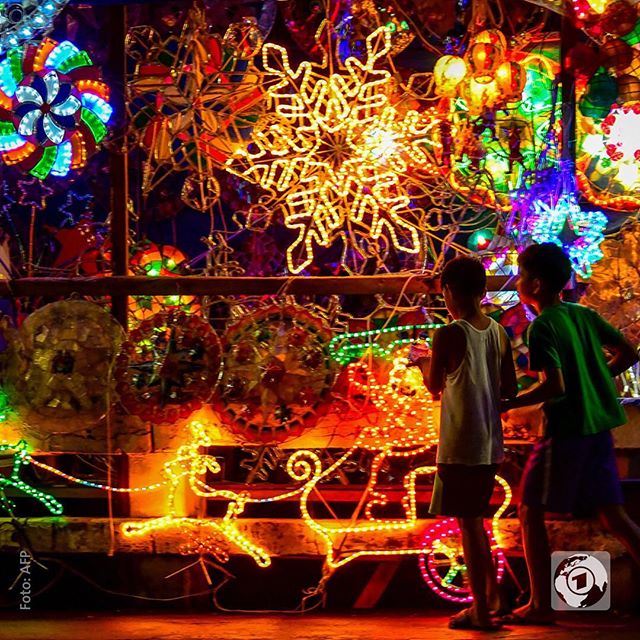
Everyone knows about Christmas lights, but the Philippines has the parol (lantern) , a Christmas ornament unique to us. Traditionally, parols come in the shape of a big circle with a star in the middle, but you can also choose from various designs like stars and flowers. It can also be made from different materials like plastic, wire, wood, or even recyclable materials.
The parol was originally made to hang on lamp posts to guide mass-goers to Simbang Gabi , but now they can be found everywhere like outside houses, in malls, and in offices.
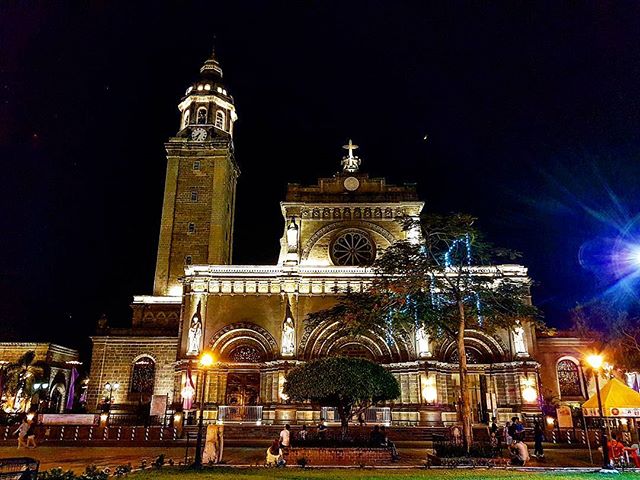
Simbang Gabi means “night mass”, which is basically what it is. Filipinos attend mass either late at night or in the wee hours of the morning for all 9 days before Christmas. We try to complete all 9 days, both as a religious practice and because of the belief that attending all 9 masses will grant you a wish.
To go with the season, churches are decorated to add a Christmas flair, and vendors often sell local Christmas goods like bibingka and puto bumbong outside after the mass.

Staying up or getting up for Simbang Gabi might make you hangry , but a serving of bibingka and puto bumbong should do the trick and calm you down. These are the two most popular and most loved Christmas treats that Filipinos never miss out on.
Both are variations of rice cakes – bibingka is baked in clay pots and leaves, while puto bumbong is steamed in bamboo tubes.
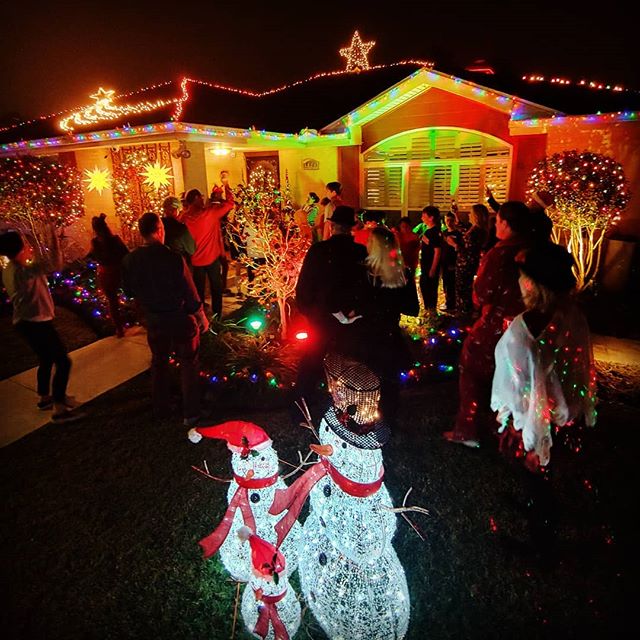
For most countries, Christmas caroling means a whole production of good vocals, coordinated outfits, instruments, and well-practiced Christmas tunes. For us, it’s become a humorous affair.
Filipino kids and adults alike go from house to house, starting from early December. Lyric books and Christmas costumes are ditched for recycled instruments and made-up lyrics. From the a-brim-bram-brooms to the jinggom bells , caroling is a sure mark that Christmas is coming.
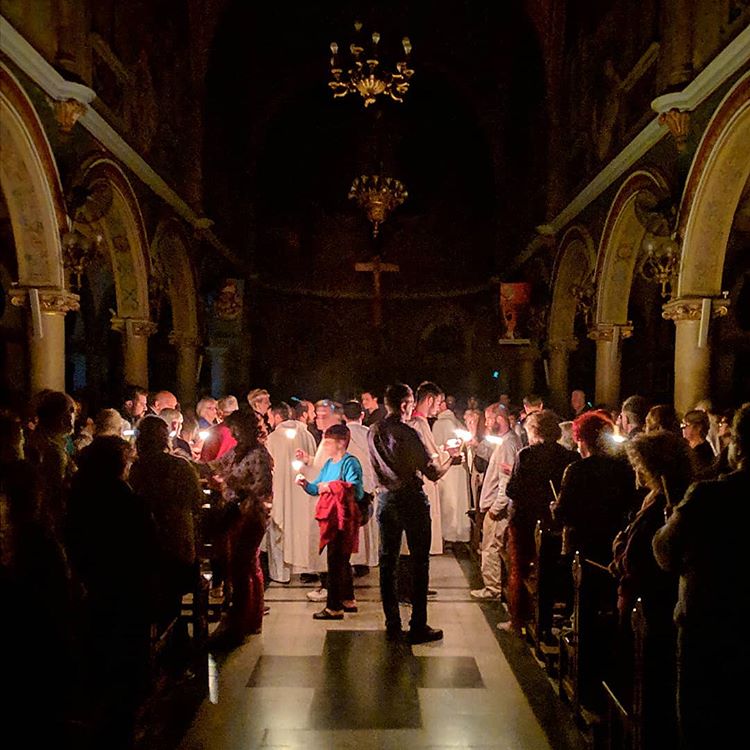
Regular Sunday masses follow a routine, but everything is extra special on Christmas. The Christmas mass that most Filipinos attend, Misa de Gallo , differs from regular Sunday mass. It’s a celebration that includes lighting candles, projector displays, and sometimes a re-enactment of the story of how baby Jesus was born
Misa de Gallo is also the first mass after the 9 days of Simbang Gabi . It is believed that if you go to all 9 days of Simbang Gabi , your wish and prayer can come true .

It’s one of the most undeniable Filipino Christmas traditions to take a long holiday during Christmas season. Christmas is a time for families and friends to come together. Many Filipinos travel long distances to reunite with relatives and celebrate the holiday with joyous gatherings and feasts.
Extended family reunions during the Philippine Christmas season are grand affairs that often span several days. Family members from near and far come together, filling homes with laughter and merriment. The atmosphere is festive, with an abundance of delicious food, joyful storytelling, and games.
These reunions remind Filipino families of the strong bonds that unite Filipino families, fostering a sense of togetherness and love that makes the Christmas season truly heartwarming and magical.

Most people eat their Christmas dinner either on Christmas Eve or Christmas night, but Filipinos often wake up at midnight to welcome Christmas day with Noche Buena , a lavish feast of traditional Filipino Christmas dishes like lechon , queso de bola , hamon , spaghetti, and fruit salad.
A lot of Filipino families are separated for most of the year, with kids off at college and parents going overseas for work. The mundane act of preparing Noche Buena is also something we look forward to because it’s a time to prep meals and cook together as a whole family.

Exchanging gifts the straightforward way is boring, so we put a Filipino twist on it. Not only do you have to find the perfect present for your manita or manito , but you also have to describe them, have everyone guess who it is, and sing the classic I Love My Manita/Manito Yes I Do song before giving your gift.
It sounds like a lot of work, but ‘tis the season of giving, and it’s a joy to see how happy everyone gets from all their gifts.

This is for the kids who are on the lookout for their ninangs and ninongs all season long. Gifts are fun to unwrap, but receiving a red envelope is just as exciting. Gifted by godparents to their godchildren, the money in these ang pao often goes to savings or a nice treat for yourself for the Christmas season. Whether you receive P20s or the big blue ones, we should never forget to be grateful.
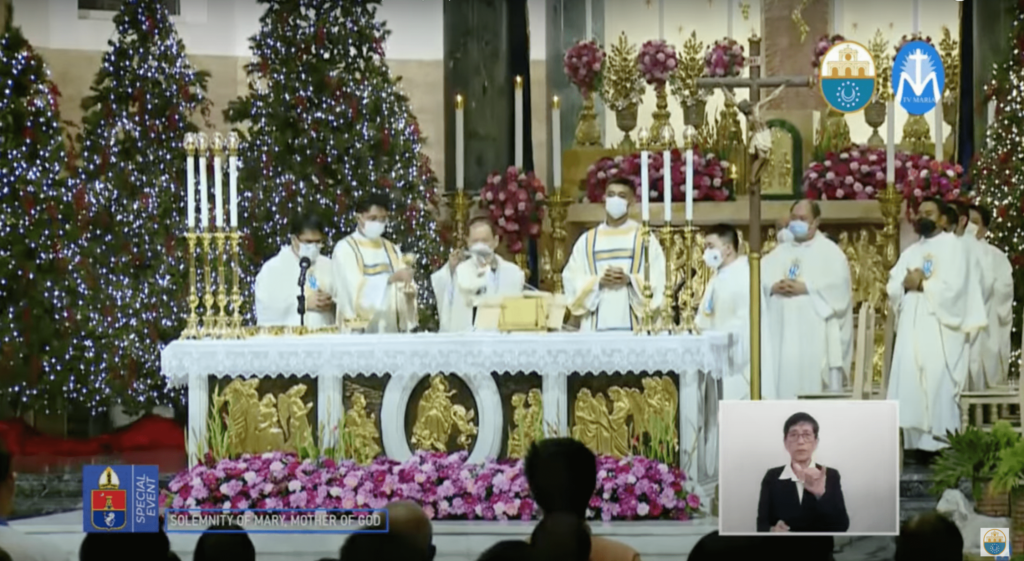
Beyond your usual midnight mass, and for those who can’t make it, one of the most recent Filipino Christmas traditions we observe is attending live-streamed masses. Christmas Eve Masses are now live-streamed, allowing family members who are abroad or unable to attend in person to participate in the religious tradition.
These live-streamed masses offer a profound sense of connection, enabling family members and loved ones, even if scattered across the globe, to virtually gather and share in the spiritual blessings of the season. It’s a heartwarming experience as people join in prayer, sing hymns, and listen to the message of hope and renewal, all while feeling intimately connected to the religious traditions that hold a special place in Filipino hearts.
In this digital age, the live-streamed masses not only provide a way to participate but also underscore the resilience and adaptability of the Filipino faith, ensuring that the Christmas and New Year’s celebrations remain deeply meaningful for all, regardless of physical proximity.
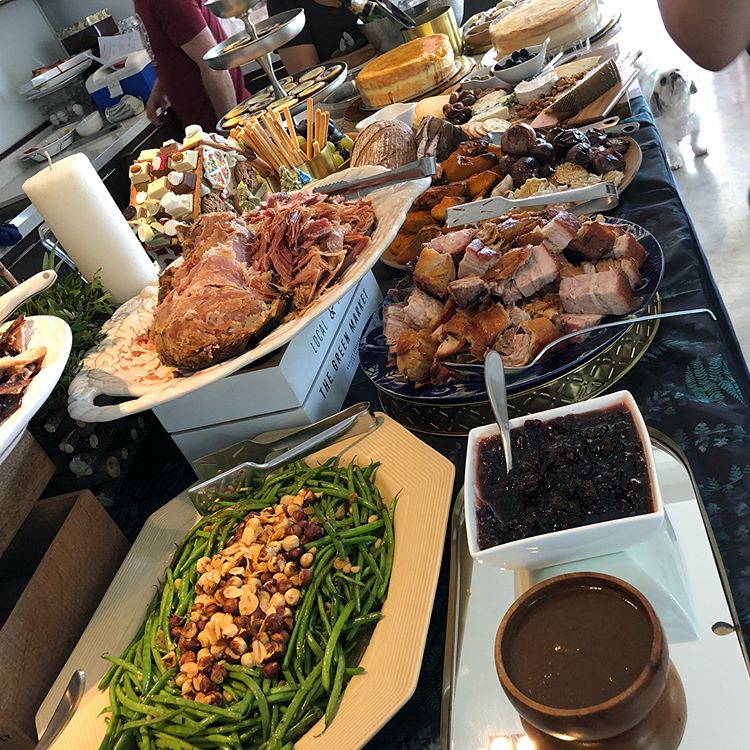
Christmas doesn’t end on the 25th for us Filipinos. While most welcome the new year by partying it up with friends, our family-centric culture observes one more lavish feast – Media Noche . The table is usually adorned with food formed into round shapes and an assortment of 12 round fruits since circles are believed to bring in good fortune.
Aside from that, there’s also the belief that loud sounds will keep evil spirits from entering the new year, so we make as much noise as possible when the clock strikes midnight – be it with car alarms, instruments, a torotot , or sparklers and firecrackers.
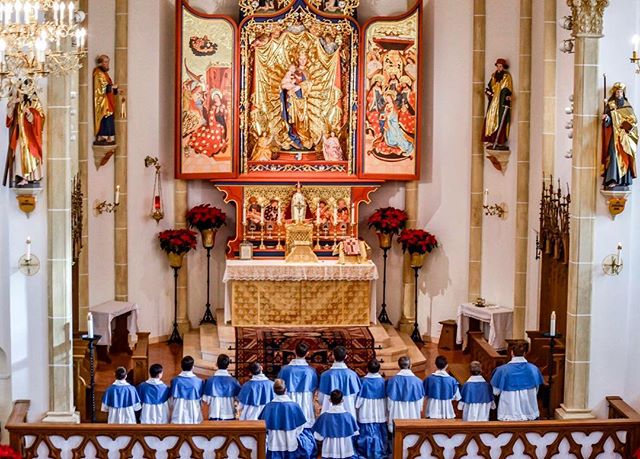
Even our priests say Christmas isn’t over until January. The Feast of the Three Kings, or the Epiphany, is the celebration of the day the Three Kings reached Jesus’ manger. It’s also considered the last day of our lengthy Christmas season. Epiphany occurs on the first Sunday of January, which means Christmas continues until well into the new year.
Our Christmas may not involve making snow angels or being bundled up in thick coats and scarves, but that doesn’t mean we don’t know how to have a good time. Though the Yuletide is well-known for its snowy and winter celebrations, our sunny, tropical country and our Christmas traditions make the holiday season warm and bright.
Shopping early for Christmas gifts? Check out these gift ideas your friends and family would love. You can also dine at Cafe Claus in Quezon City to really feel that Christmas vibes.
Cover image adapted from: @ alwayshungryph via Instagram , @mhayapotzkee via Instagram , @taggeschau via Instagram , and Google Images
Article originally published on 20 December 2019 by Hazel Lumbre. Last updated by Gly Parañal on 22 September 2023.

Get more stories like this.
Drop us your email so you won't miss the latest news.
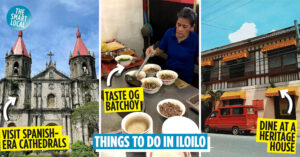

Essay on Christmas In The Philippines
Students are often asked to write an essay on Christmas In The Philippines in their schools and colleges. And if you’re also looking for the same, we have created 100-word, 250-word, and 500-word essays on the topic.
Let’s take a look…
100 Words Essay on Christmas In The Philippines
Introduction to christmas in the philippines.
In the Philippines, Christmas is a joyful time filled with traditions. It’s the longest holiday celebration in the country, starting in September and lasting until January. People are very excited and start preparing early.
Decorations and Lights
Filipinos love to decorate their homes with colorful lights and lanterns called ‘parols’. These lanterns are star-shaped, reminding them of the star from the Christmas story. Streets and houses shine brightly at night.
Simbang Gabi
A special church service called ‘Simbang Gabi’ happens for nine days before Christmas. Many Filipinos wake up before sunrise to attend these masses, showing their faith and anticipation for Christmas.
Christmas Food
Food is important during Christmas in the Philippines. Families enjoy a midnight feast called ‘Noche Buena’ after the last mass. They eat delicious dishes like ‘lechon’ (roast pig) and sweet ‘bibingka’ (rice cake).
Gift Giving
Giving and receiving gifts is a big part of Christmas. Children often receive money or presents from their elders in a tradition called ‘aguinaldo’. It’s a time of sharing and caring for others.
250 Words Essay on Christmas In The Philippines
The longest christmas season.
In the Philippines, Christmas is not just a day; it’s a season. It starts in September and lasts until January. This is the longest Christmas celebration in the world. Filipinos start playing carols and decorating their homes with bright lights and colorful ornaments as soon as the “Ber” months arrive.
Simbang Gabi Tradition
One special tradition is Simbang Gabi, which means “Night Mass.” For nine days before Christmas, people wake up before the sun rises to attend these early morning church services. It’s believed that if you complete all nine masses, your wish will come true.
Christmas Decorations
The streets and houses are full of decorations. The most famous is the parol, a star-shaped lantern that represents the Star of Bethlehem. Made from bamboo and paper, it shines brightly in many colors, showing the way to Christmas joy.
Christmas Eve and Noche Buena
On Christmas Eve, families come together for Noche Buena, a big feast at midnight. They enjoy traditional foods like lechon (roasted pig), ham, and sweet spaghetti. After eating, they open gifts and celebrate the birth of Jesus.
Gift-Giving and Caroling
Gift-giving is a big part of Christmas in the Philippines. Monito Monita is a fun exchange gift game similar to Secret Santa. Children also go caroling from house to house, singing and spreading cheer. In return, they receive money or sweets.
Christmas in the Philippines is a time of joy, family, and faith. It’s a season filled with bright lights, delicious food, and happy music, showing the warmth and generosity of the Filipino spirit.
500 Words Essay on Christmas In The Philippines
In the Philippines, Christmas is the most joyful time of the year. It is a season filled with love, happiness, and lots of celebrations. The Philippines is known for having the longest Christmas season in the world. Here, the festive mood starts as early as September and lasts until the first week of January.
Starting Celebrations Early
Filipinos start preparing for Christmas many months before December 25th. As soon as the month ending in “-ber” arrives, you can hear Christmas songs playing in homes and shops. People start decorating their houses with bright lights and colorful ornaments. One special decoration is the ‘parol,’ a star-shaped lantern that represents the Star of Bethlehem.
One important tradition is ‘Simbang Gabi’ or ‘Night Mass.’ This is a series of nine church services held very early in the morning, starting from December 16th to Christmas Eve. Many believe that if you attend all nine masses, you can make a wish, and it will come true. After each service, people enjoy eating traditional Filipino Christmas food like ‘puto bumbong’ and ‘bibingka,’ which are types of rice cakes.
Christmas Eve is a special time when families come together. They attend a midnight mass called ‘Misa de Gallo,’ which means ‘Rooster’s Mass.’ After the mass, everyone enjoys a big feast called ‘Noche Buena.’ This meal is an important family event and includes delicious dishes such as ‘lechon’ (roasted pig), ‘hamon’ (Christmas ham), ‘queso de bola’ (edam cheese), and ‘fruit salad.’
Gift Giving and Caroling
Gift-giving is an essential part of Christmas in the Philippines. People exchange gifts with family and friends to show love and care. Children also enjoy receiving ‘aguinaldo,’ which is money or gifts from their elders. Another fun activity is caroling. Groups of children go from house to house singing Christmas songs. In return, they are given small amounts of money or sweets as a thank you.
Christmas Day
On Christmas Day, families attend church together to celebrate the birth of Jesus. The rest of the day is spent visiting relatives, eating more delicious food, and having fun. Children play with their new toys, and everyone enjoys the holiday atmosphere.
Christmas in the Philippines is a unique and magical time. It is filled with traditions that bring families and communities together. From the early ‘ber’ months to the joyful ‘Simbang Gabi’ and the festive ‘Noche Buena,’ Filipinos celebrate Christmas with a lot of heart and joy. The spirit of giving, singing, and being with loved ones makes Christmas in the Philippines a truly special occasion that is loved by both kids and adults.
That’s it! I hope the essay helped you.
If you’re looking for more, here are essays on other interesting topics:
- Essay on Effects Of Technology On Relationships
- Essay on Effects Of Globalization In The Philippines
- Essay on Christmas Party
Apart from these, you can look at all the essays by clicking here .
Happy studying!
Leave a Reply Cancel reply
Your email address will not be published. Required fields are marked *
Save my name, email, and website in this browser for the next time I comment.
- Beelinguapp
- “Maligayang Pasko” & More Useful Christmas Words In Tagalog
“Maligayang Pasko” & More Useful Christmas Words In Tagalog
Believe it or not, the Christmas season starts as early as September in the Philippines. Not that December lasts about four months in Filipino time. It’s just that Filipinos love the heartwarming feels of the yuletide season , so Christmas there is celebrated for a bit longer. Anyway, another reason why Christmas starts really early could be… because September ends in the suffix -ber. And if you’ve paid close attention, December also ends in -ber. Which means that both months (September and December) rhyme. Therefore, you could say that the months with the -ber suffix signals the beginning of the “Ber” months. It goes without saying that the -ber endings are really just code for Christmas time. So from September – don’t forget October and November – to December, the holiday cheer is all around. With that being said, it is more than safe to say that Christmas is one of the most important celebrations in the Philippines. Of course, lots of traditions and festivities happen in between all the days leading up to the happy holidays. Nevertheless, it is the Christmas spirit and magic that is something special to many Filipinos around the world.
- Merry Christmas : Maligayang Pasko (mah-lee-ga-yang pas-ko)
- Christmas : Pasko (pas-ko)
- Christmas tree : Christmas tree (kris-mas tree)
- fireworks : paputok (pah-pu-tok)
- snow : niyebe (nee-yeh-beh)
- angel : anghel (ang-hel)
- Santa Claus : Santa Claus (san-tah klaws); Santa Klaus (san-ta klaws)
- Christmas lantern : parol (pa-rol)
- Nativity scene : belen (be-len)
- Christmas day : araw ng Pasko (ah-raw nang pas-ko)
- stocking : medyas (med-yas)
- guest, visitor : bisita (bee-see-tah)
- candle : kandila (kan-di-lah)
- cheese ball : queso de bola (keh-soh de boh-lah)
- candles : mga kandila (ma-nga kan-di-lah)
- The Three Kings : ang tatlong hari (ang tat-long ha-ri)
- Midnight mass or Rooster’s mass : Misa de Gallo (mi-sa de ga-yoh)
- night mass : Simbang Gabi (sim-bang gah-bi)
- elf : duwende (du-wen-deh)
- chestnuts : kastanyas (kas-tan-yas)
- wreath : wreath (reeth)
- bell : kampana (kam-pa-na)
- Christmas Eve : Bisperas ng Pasko (bis-pe-ras nang pas-ko)
- Christmas gift (usually refers to gift in the form of money) : aguinaldo (ah-gi-nal-doh)
- Christmas gift : pamasko (pa-mas-koh)
- Christmas Eve feast : Noche Buena (no-che bwe-na)
- stars : mga bituin (ma-nga bit-win)
- church : simbahan (sim-ba-han)
- hot chocolate : tsokolate (cho-ko-la-teh)
- ornaments : mga palamuti (ma-nga pa-la-moo-ti)
- Saint Nicholas : San Nikolas (san ni-ko-las)
- reindeer : reindeer (reyn-deer)
- it’s Christmas again : Pasko na naman (pas-ko na na-man)
- December : Disyembre (dis-yem-breh)
- Christmas caroling : karoling (kah-roh-ling)
Related Posts
Say thank you in 10 languages, easy language learning hacks to try today for faster results, easy polish phrases & simple questions to master, subscribe to our newsletter.
How We Celebrate a Traditional Christmas in the Philippines
It's that month of the year again! That month where Santa Claus would drop down by the chimney to present some gifts to those little boys and girls who were nice and not naughty. The month where everybody gets busy just to buy a gift and give it to their loved ones. But how do we celebrate Christmas here in our country? Read on and celebrate this jolly season with us!

Christmas here in the Philippines starts with the usual houses you always see adorned with Christmas lights. It's in that moment you realize that Christmas is getting near. Usually, some households would place some Christmas decorations as early as October.
Sround late November, you'll be surprised when some children go in front of your gate singing Christmas carols. It's up to you if you have spare change or are in the mood for some Christmas spirit! If you do, then you have to give a couple of pesos to the kids. Also, you would hear Christmas songs (I might guess 65% from singer Jose Mari Chan ) all over the radio. That would basically remind you that Christmas is warming up.
Being a student in a public or private school (or one who works in an office), one could never get away with the so-called “Christmas Party”. This signals the end of school days on December and opens the door for Christmas vacation. If you are a parent, you would find yourself asking your children about their gifts for their “secret Santas”. On day one, it has to be something red. On day two, something soft. On day three, something sweet. And the list goes on and on and on. This also goes for the people who work at offices or in some other establishments.
The moment Christmas vacation arrives, one has to stretch out his arms and get ready for a very long vacation. One must never forget to buy hamon de bola (because I think without this, Noche Buena is meaningless) as early as possible.

Everybody actually gets busy during Christmas. Banks are always full, people queue up in the cashier booths, children would grab a lot of toys and gifts because their papa or mama would come home from overseas... such are scenes that you would see at the height of Christmas vacation. Simbang gabi , a nine-day Roman Catholic ritual novena performed in the Philippines, starts nine days before Christmas. It ends on December 24 and most Filipinos would bravely wake up by four in the morning just to attend the nine-day mass. What do they get from that? A grateful wish for better health and a better life in the coming new year.
But the most cherished moment during Christmas is on... of course, Christmas Day. Well actually, the thrill starts on the morning of December 24, Christmas Eve. People get busy baking and cooking food in preparation for the Noche Buena! A lot of Filipinos would attend Misa de Gallo or Midnight Mass. This also marks the end and the final mass of simbang gabi (loosely translated as night mass ). Filipinos after that would cater to their pangs of hunger and thirst for good food like puto bumbong (a purple-colored rice pastry, seasoned with grated--coconut and brown sugar), tsokolate (a hot chocolate drink), bibingka (flour and egg cakes cooked with coals on top and bottom), and salabat, or ginger tea, which are sold to the faithful by vendors outside the different churches and parishes here in the Philippines.
Come 12:00 AM of December 25, children would wake up and see their gifts under the big Christmas tree. Almost a lot of the children would receive toys from the make-believe Santa Claus, while parents and other siblings would lovingly hug and greet each other "Merry Christmas" . It's indeed the most wonderful time of the year.
After ransacking Santa Claus' gifts, the whole family would proceed to the dining table and enjoy their Noche Buena. One would always find lechon, bibingka, hamon de bola, quezo de bola, spaghetti, fruits, pancit, lumpia, and rice on the table. Desserts sometimes include ice cream, coffee, pastries, and cakes. The adults would indulge in wine, liquor or beer to celebrate the essence of Christmas.

In conclusion, spending a Christmas in the Philippines with a Filipino family is awesome. But also, we should never forget that it's not all about the activities that we do during the lengthy time of the season. It's also that time we should remember the one who is the reason why we are celebrating Christmas. :-)
Happy holidays, everyone!
This is a post submitted by Community Member ethermoon .
written by ethermoon on 2010-12-24 #lifestyle #philippines #tradition #holidays #christmas #loving-the-season
rdetoyato , grazie , pattyequalsawesome , gelagoo , mandriva , cruzron , stouf , tallgrrlrocks , sergio_m , antibiotyx , novakmisi , icuresick , spoeker & chaoticsense .
10 Comments

maligayang pasko! feliz navidad! joyeux noel!

Maligayang pasko! :D

Maligayang Pasko sa inyong lahat!

Maligayang Pasko, kaibigan! =)

oh sweety! you always will go to bed knowing something more! this night from philipines!

maligayang pasko at manigong bagong taon!

maligaya sana ang naging pasko ninyo :) ang good idea ng mga supot ng icecandyyyy. makikigaya ako hehe :D

puro pinoy lang nag comment? hahahaha

I miss this type of celebration! Maligayang Pasko! :)

Woohooo, happy holidays to you ethermoon! And everyone on Lomography. Great article! <3 P.S. I laughed when you wrote about Christmas Carols being 65% Jose Mari Chan--that's quite true. haha :p
More Interesting Articles
Lomography pioneers: double trouble with @jeabzz.

In this edition of Lomography Pioneers we take a look at Jean Baptiste Saint-Pol's work and impact on the Lomography community, from showing how far it is possible to take multiple exposures to forming his own group called Les Parisiens.
Community Member @lalomixu’s First Impressions With the LomoApparat

Community member and camera store co-owner Eduardo Espinoza Chávez (@lalomixu) tells us about his first roll with the LomoApparat, which he took along with him to various occasions and environments, testing its flexibility as a daily camera companion.
Alternative Processes: Lith Printing with @Marek_

Film photographer and community member Marek (@marek_) gives us a lesson in lith printing, from making the prints in the darkroom to digitalizing and uploading them on his LomoHome. He also shares tips for others wanting to try out the alternative printing process.
Your Quick Guide to Analogue Photography

Don’t know your 35 mm from your 110? Never heard of medium format? Confused about cross-processing? This guide gives a brief overview of everything analogue and you’ll be an expert in no time! Get a head start with film photography with our downloadable 12-page PDF guide.
New York Angles: Brian Cho's Ultra-Wide Shoot with the Atoll Art Lens
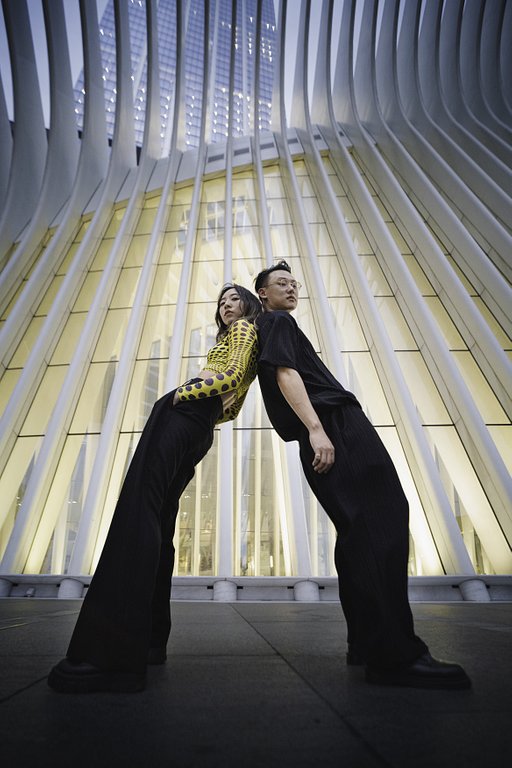
A while back, we sent photographer Brian Cho one of our Atoll Ultra-Wide 2.8/17 Art Lenses to test out, in a place none other than New York City. He's here today to chat with us about what he's been up to and his experience shooting with the lens!
Why We Love to Shoot 110 Format Film

Why do we love the 110 format so much? Is it the grain, the pocketability, the convenience or the nostalgia? It's everything and more! In this article, community members answer this one simple question about the beloved format.
Around the World in Analogue: Ayvalık, Turkey

Community member Melda Orcan tells us about the old seaside town of Ayvalık in the Northern West side of Turkey, widely-known for its beaches, food culture and historical architecture which she captured on Lomography Color Negative 400 film.
Three Lenses in One – Nour Triplet v 2.0/64 Bokeh Control Art Lens

Ignite the legacy of a fascinating but forgotten scientist, Ibn al-Haytham, and become a master of light with this unique lens designed for spherical aberration control on full-frame mirrorless cameras. Shipping Live Now!
Davis Chee's First Impressions of Our New Lomomatic 110 Film Camera

We invited Davis Chee, a Hong Kong film enthusiast, to shoot with Lomography’s new Lomomatic 110 film camera! As a newbie to the 110 format, let’s take a look at how he captures daily life with this 110 camera, and hear about his experience of using it for the first time!
The Essence of Ballroom: Interview with Analogue Photographer Chai Saeidi

Norwegian-Iranian artist Chai Saeidi has been documenting the ever-expanding ballroom scene in Scandinavia for the past few years. In this interview we spoke with Chai about their experience capturing the essence of Ballroom and its significance in queer communities.
Jan Narciso's LomoChrome Color '92 Medium Format First Impressions

We sent California-based photographer Jan Narciso a roll of our LomoChrome Color '92 medium format film and he's here today to show his results! Jan tested the film in a low light setting with and without flash, and gives us his general impressions of shooting with this film stock.
Bundle Up and Save!

On the look for a great deal? In need for the perfect gift? Not sure what film to get with your camera? Worry not and discover our budget friendly bundles including sweet discounts and freebies for many different products! Don´t miss a great deal and check them out now!
Available in our Shop
The Darkroom at Beach Creative with Emily Rose Parris

In this interview we get to know Emily Rose Parris, a Kent-based artist who set up The Darkroom at Beach Creative in Herne Bay. She talks to us about her love of analogue photography and how the industry has been rapidly changing.
The Slow Film Photographer – Yu Huapen and Lomography Color Negative Film

In this interview we get to know Yu Huapen. He tells us how he sees film photography as a medium that helps him to deeply examine and understand the world around him, and shares with us his photos taken with Lomography color negative film.
The Line Between Chaos and Harmony: An Interview with Film Photographer Cato Lein

We speak with photographer Cato Lein about storytelling, curiosity and 'vemod', the Swedish word for a feeling somewhere in between melancholy, grief and tenderness. He tells us about his ongoing project, 'The Poet and the Baltic Sea', inspired by the Nobel Prize winning poet Tomas Tranströmer.
Find Out More About

Christmas in the Philippines

People in the Philippines like to celebrate Christmas for as long as possible! The playing of Christmas carols in shops can start in September! The formal Christmas celebrations start on 16th December when many people go to the first of nine pre-dawn or early morning masses. The last mass is on Christmas day. The Christmas celebrations continue to the First Sunday in January when Epiphany or the Feast of the Three Kings is celebrated.
In the Philippines the early masses held before Christmas are called the 'Misa de Gallo' or 'Simbang Gabi' in Filipino.
Most Filipinos are Christians with about 80% of people being Catholics. It's the only Asian country with so many Christians. Because of this, Christmas is the most important holiday in the Philippines. December is actually one of the 'cooler' months of the year in the Philippines. The Philippines only has two real seasons, wet (June to October) and dry (April and May). December is one of the months in between the wet and dry seasons.
Christmas customs in the Philippines are a mixture of western and native Filipino traditions. (Christianity became widely known in The Philippines in the 1500s when missionaries from countries like Portugal and Spain traveled to the area.) So people in the Philippines have Santa Claus (or 'Santa Klaus'), Christmas trees , Christmas cards and Christmas carols from western countries!
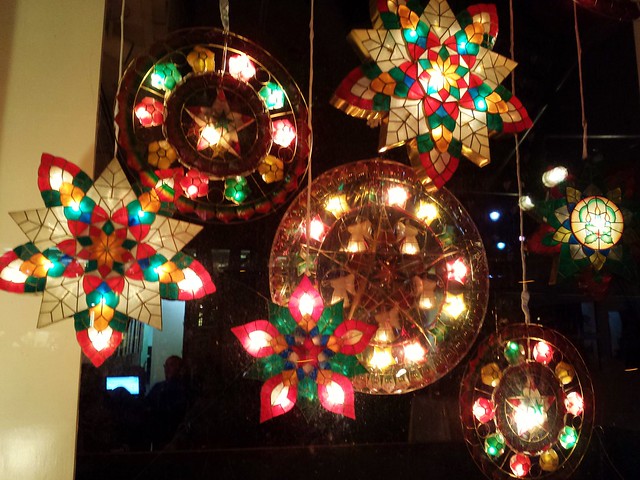
They also have their own Christmas traditions such as the 'parol' which is a bamboo pole or frame with a lighted star lantern on it. It's traditionally made from bamboo strips and colored Japanese paper or cellophane paper and represents the star that guided the Wise Men. It is the most popular Christmas decoration in the Philippines.
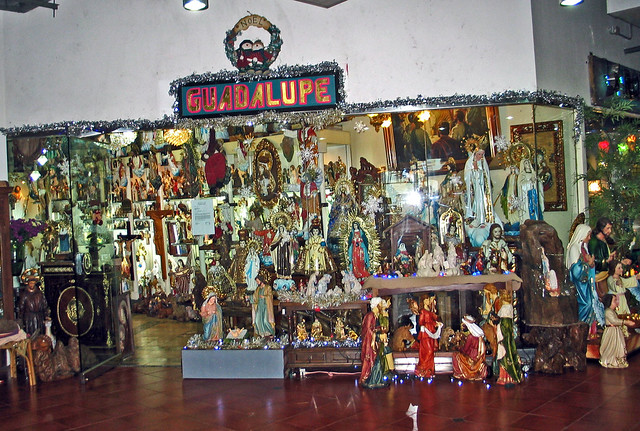
Christmas Eve is very important in the Philippines. Many people stay awake all night into Christmas day! During Christmas Eve evening, Christians go to church to hear the last 'simbang gabi' or the Christmas Eve mass. This is followed by a midnight feast, called Noche Buena.
The Noche Buena is a big, open house, celebration with family, friends and neighbors dropping in to wish everyone a Merry Christmas! Most households would have several dishes laid out and would normally include: lechon (roasted pig), ham, fruit salad, rice cakes (bibingka and puto bumbong are traditional Christmas foods) and other sweets, steamed rice, and many different types of drinks.
One very special person who helps people in the Philippines celebrate Christmas is Santa R-Kayma Klaws. He is a Filipino citizen, in his 70s and is of Irish descent. He has been spreading Christmas cheer among poor Filipino children by dressing up as Santa Claus during charity missions and corporate events in poor areas of the Philippines for over 50 years. He has a 'giant motor sleigh' (an air-conditioned bus!) that is used in many missions all over the Philippines. Santa R-Kayma Klaws owns the Philippines' only reindeer farm at Mt. Isarog in Barangay Sta. Cruz, Ocampo, Camarines Sur. The farm is open to the public for free. You can find out more about him and his work on his website: http://pacificsantas.com (goes to another site).
The Philippines has eight major languages, here's how to say Merry Christmas in some of them! In Tagalog, Happy/Merry Christmas is 'Maligayang Pasko'; in Ilocano it's 'Naragsak nga Paskua'; in Ilonggo it's 'Malipayon nga Pascua'; in Sugbuhanon or Cebuano it's 'Maayong Pasko'; in Bicolano they say 'Maugmang Pasko' in Pangalatok or Pangasinense they say 'Maabig ya pasko' or 'Magayagan inkianac'; and in Waray you say 'Maupay Nga Pasko'. Happy/Merry Christmas in lots more languages .
In 2013 the Philippines was hit by Typhoon Haiyan and thousands of people were made homeless, so lots of people can't celebrate Christmas like they used to. Many charities like Compassion are working in the Philippines to help people. Find out more about the Philippines on the Compassion website (goes to another site).
PHOTO ESSAY: Christmas In The Philippines
Christmas in the Philippines is a really big deal. So much so, that you can find Christmas music playing in the local shops as early as September. @Jay Directo| Getty Images The Southeast Asian country begins their official Christmas celebrations on December 16. This date is when people attend the first of nine pre-dawn mass services. These masses are called ‘Misa de Gallo’ or ‘Simbang Gabi’ in Filipino. The final mass is held on Christmas day. @Jeremy Villasis| Getty Images Related: Philippines ‘Boracay Island” Opens Back Up For Tourists, But Don’t Expect To Party Christianity became popular in the Philippines in the 1500s after missionaries from Portugal and Spain traveled to the area. @Jay Directo| Getty Images The Philippines has the highest percentage of Christians among all Asian countries, with about 80 percent of the people being Catholic. Christmas traditions are a mix of western and native Filipino cultures. You can find the standard representations of the holiday, such as...
DeAnna Taylor • Dec 21, 2018
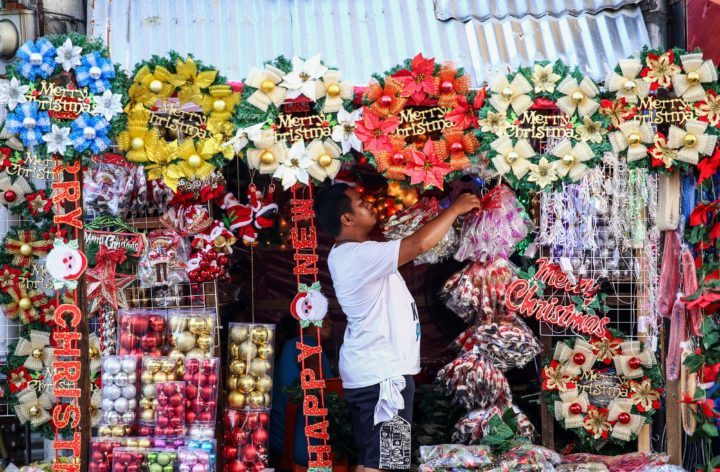
Christmas in the Philippines is a really big deal. So much so, that you can find Christmas music playing in the local shops as early as September.
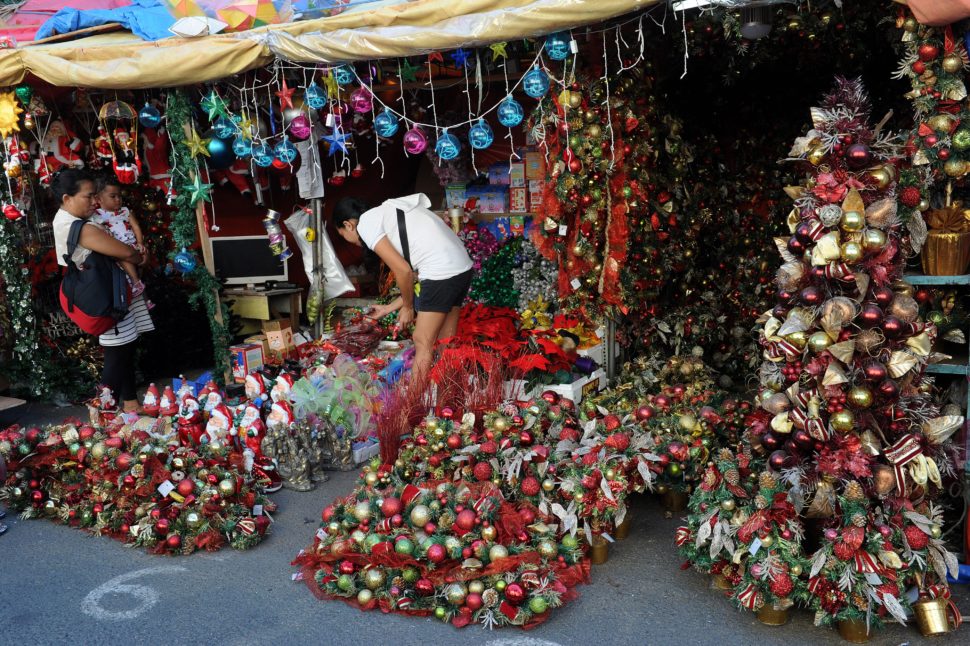
The Southeast Asian country begins their official Christmas celebrations on December 16. This date is when people attend the first of nine pre-dawn mass services. These masses are called ‘Misa de Gallo’ or ‘Simbang Gabi’ in Filipino. The final mass is held on Christmas day.
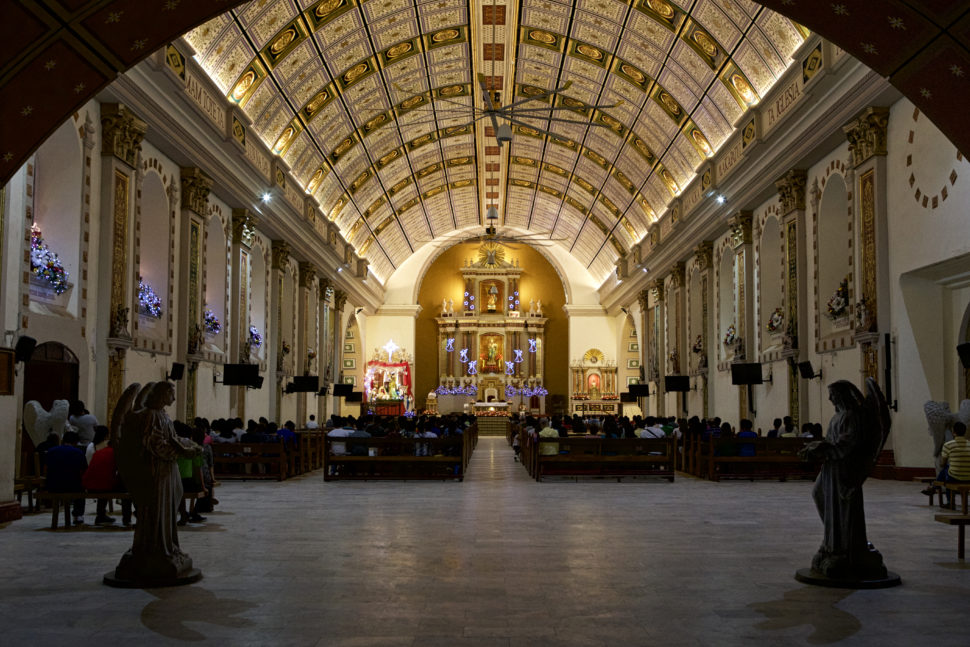
Related: Philippines ‘Boracay Island” Opens Back Up For Tourists, But Don’t Expect To Party
Christianity became popular in the Philippines in the 1500s after missionaries from Portugal and Spain traveled to the area.
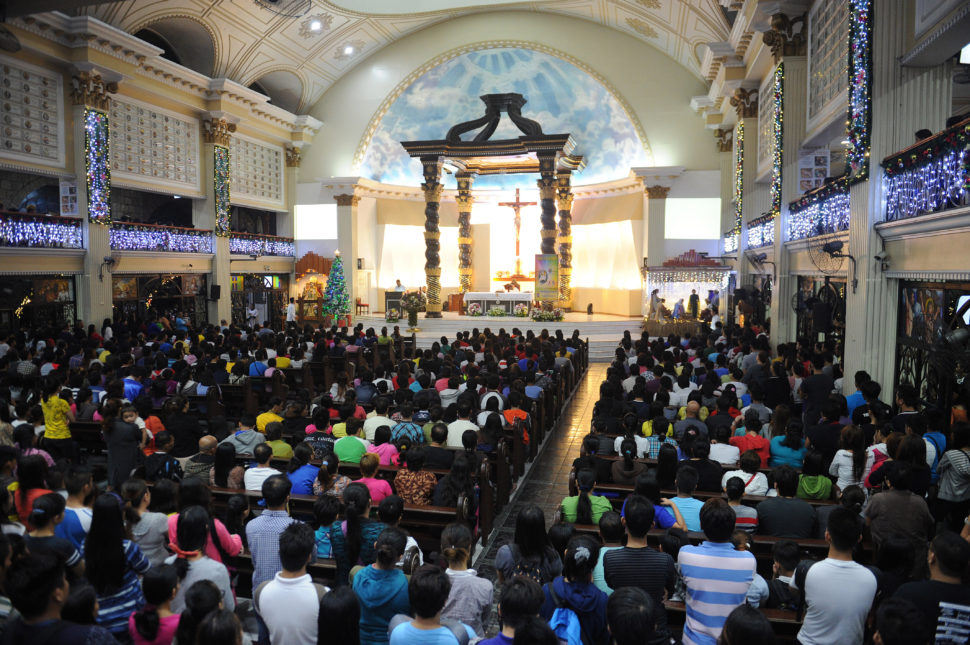
The Philippines has the highest percentage of Christians among all Asian countries, with about 80 percent of the people being Catholic. Christmas traditions are a mix of western and native Filipino cultures. You can find the standard representations of the holiday, such as Santa Claus, Christmas trees, and Christmas carols. However, you can also find native representations as well, like the ‘parol’ which is a bamboo pole shaped into a circle with a lighted star lantern in the center. The lantern represents the star that guided the Three Wise Men.
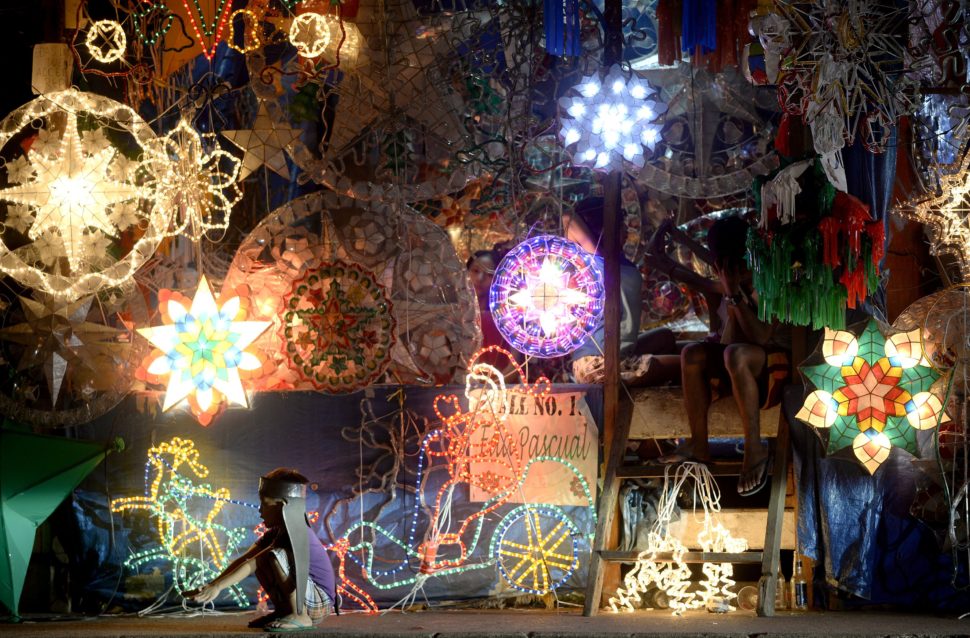
On Christmas Eve, many of the people stay awake all night into Christmas Day. During Christmas Eve, Christians go to a mass called ‘simbang gabi.’ Mass is followed by a great feast at midnight called Noche Buena. Noche Buena is a big, open house gathering of family, friends, and neighbors. People drop in and out to wish each other a Merry Christmas.
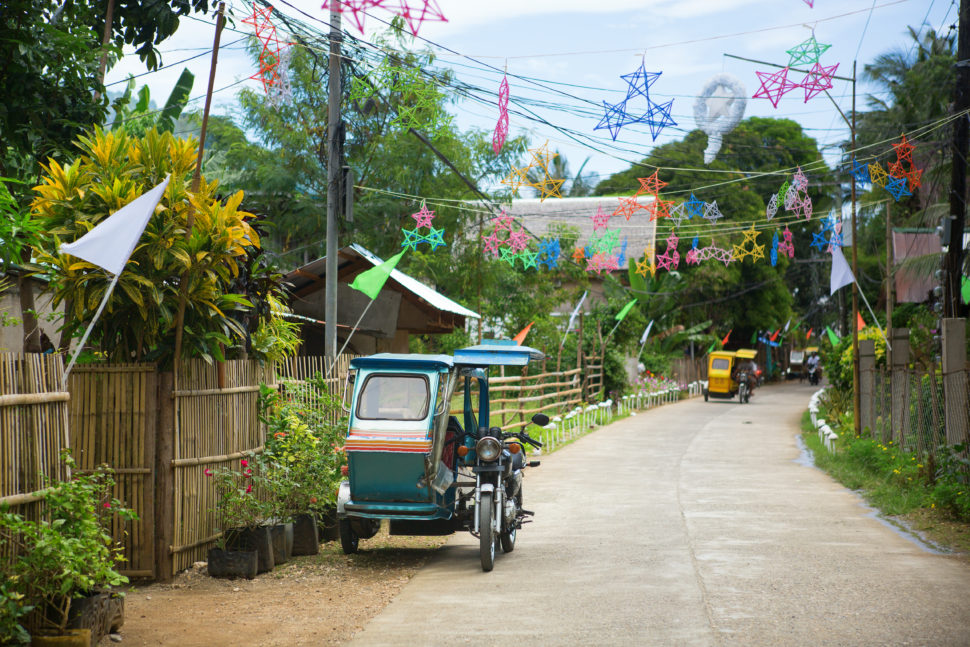
Households prepare a selection of native dishes such as lechon (roasted pig), ham, rice cakes, and other sweets.
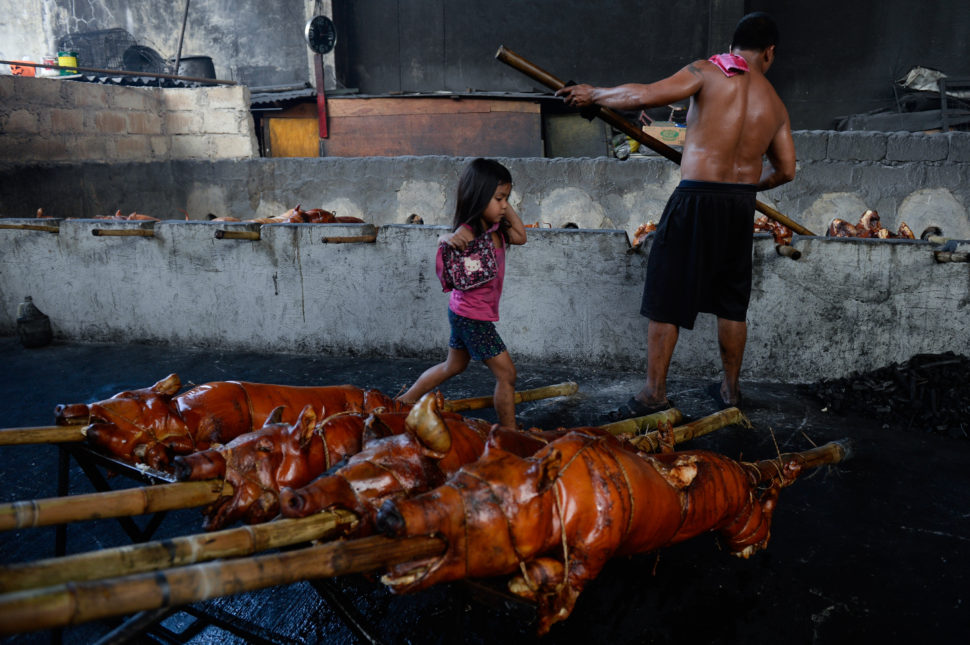
On Christmas day, lunch is prepared for the extended family where they open presents, eat, play games, and sing karaoke. Older members of the family are revered and traditions, such as Pagmamano (taking the older family member’s hand and gently placing it on one’s forehead as a sign of respect), are practiced. The day finally ends when people can no longer eat from being full.
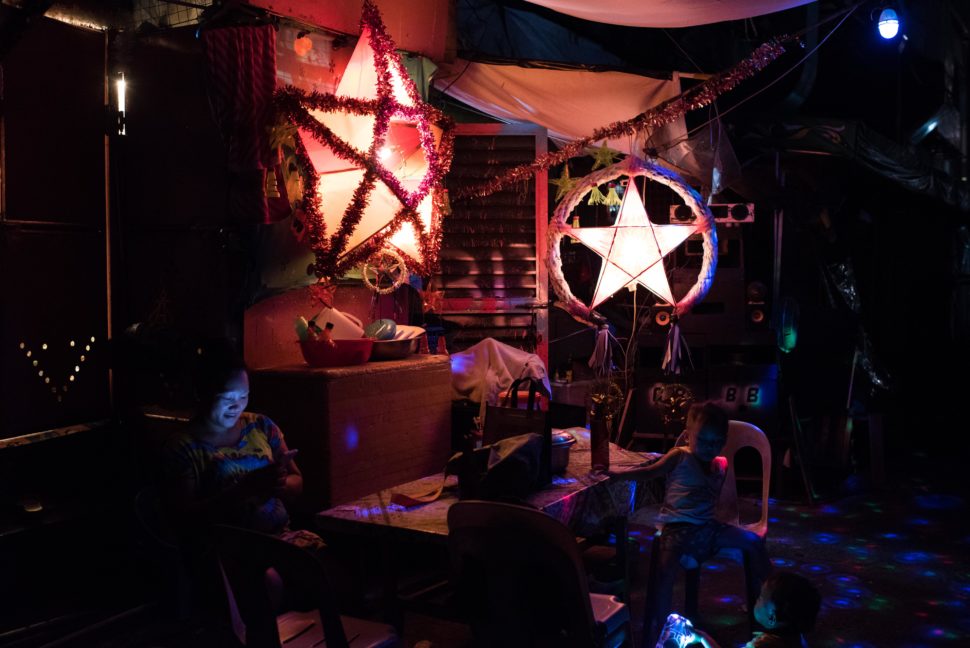
In 2013, the country was devastated by Typhoon Haiyan and many were left homeless. Therefore, many families cannot celebrate the holiday like they once did. Thankfully, many charities have helped to restore people’s way of life.
Subscribe to travel noire
Get more travel content
Subscribe to Travel Noire, a free daily newsletter that features the best of travel, destinations, and guides to the cities you love from a new point of view — yours.
By subscribing to this newsletter, you agree to our terms of service and privacy policy.
Popular posts
Trending stories in world travel

Best Christmas Message Tagalog and Greetings Collection
Filipinos celebrate Christmas the longest in the world, from September month. The Biggest and most enjoyable festival for Filipinos from 3 months back to Dec.
Every year we get ready to wish “Maligayang Pasko” to our loved ones in the event of Christmas to share our happiness with them.
We have provided here the best Tagalog Christmas messages and Christmas greetings in Tagalog with images.
You can wish a Merry Christmas in the Tagalog language to your loved ones, like your father, mother, friends, girlfriend, boyfriend, teachers, etc. with our provided greetings. Celebrate the season of joy and happiness.
Table of Contents
Christmas Message Tagalog and Tagalog Christmas Greetings
You can wish Merry Christmas in Tagalog. Here are some best Christmas messages we are given in. And Christmas greetings in Tagalog.

“Sana ang magic ng Pasko ay punan ang bawat sulok ng iyong puso at tahanan ng kagalakan – ngayon at pa lagi.”
Ang Pasko ay maaaring maging tulad ng isang malaking snowstorm, snow na umiihip sa bawat direksyon. Narito ang pag-asa na pagdating ng araw ng Pasko ay makakapag-relax ka at makikita mo ang sikat ng araw sa abot-tanaw!
“Isang napakagandang regalo ngayong Kapaskuhan ang pagbibigay ng ating sarili sa ating kapwa. At isa rin sa mahalagang aral na pagsasabuhay ng pagmamahal ng ating Panginoon sa ating mga kapatid.”
Nawa’y punan ng walang hanggang mensahe ng Pasko ang iyong puso at tahanan ng kagalakan ngayon at sa mga darating na taon.
“Nawa’y ang tunay na diwa ng Pasko ay magningning sa iyong puso at magaan ang iyong landas.”

Ang mabuting balita ay ang maluwalhating mensahe ng kapayapaan at pag-ibig ay pumupuno sa iyong puso at isipan ngayong maligayang kapaskuhan.
Kung ang isang malaking lalaking nakapula ay sumulpot sa iyong pinto na sinusubukang balutin ka ng regalo, iyon ay dahil nasa listahan ka ng aking Christmas wishlist! Maligayang Pasko sa iyo!
Marami kaming natatanggap na pagbati sa kapaskuhan na ito, ngunit ang iyong mensahe ng pag-asa, kagalakan, at pagmamahal, ay palaging espesyal sa amin sa kapaskuhan na ito ng taon. Nawa’y matamasa mo at ng iyong pamilya ang maraming alaala at maraming tawanan at pagmamahalan!
Binabati kita ng isang maligaya at maliwanag na Pasko! Umaasa kami na mayroon kang ligtas at nakakarelaks na kapaskuhan.
Nawa’y palibutan ka at ang iyong pamilya ng pagmamahal ni Hesukristo lalo na ngayong kapaskuhan. Maligayang Pasko!

“Batiin ka ng isang panahon na masaya at maliwanag na may liwanag ng pag-ibig ng Diyos.”
Magkaroon ng isang masayang Pasko! Nawa’y ang pananabik sa panahong ito ay umabot sa Bagong Taon para sa iyo
Isipin kung ang season na ito ay mananatili sa buong taon, at ang pagmamahal na ipinapakita ng mga tao sa oras na ito ng taon, ay hindi kailanman mawawala. Sana ay magkaroon ka ng magandang Pasko.
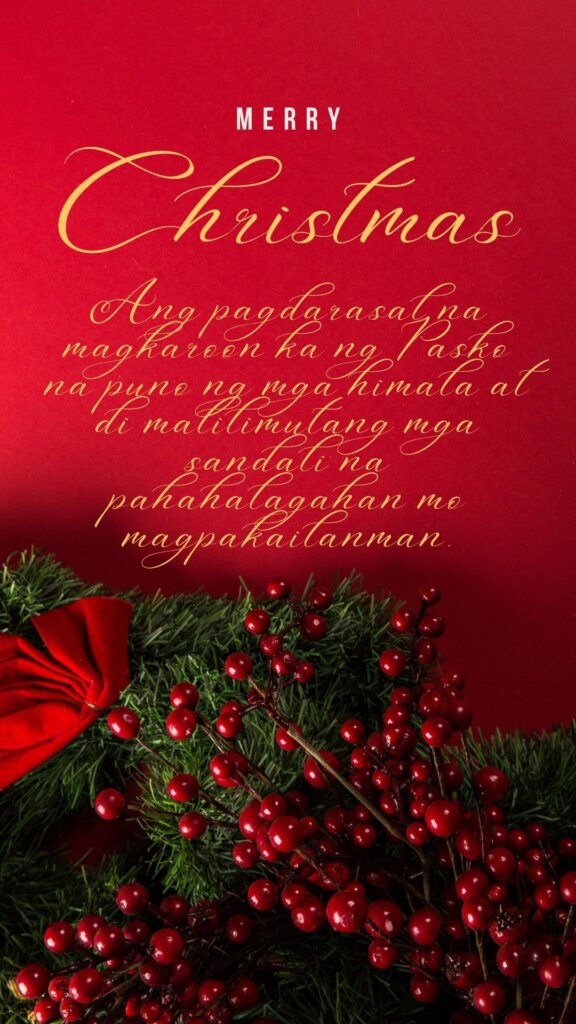
Ang pagdarasal na magkaroon ka ng Pasko na puno ng mga himala at di malilimutang mga sandali na pahahalagahan mo magpakailanman.
“ Nagpapadala ng mga panalangin at masigasig na pagbati sa Pasko sa iyo. Nawa’y matanggap mo ang pinaka-espesyal na mga pagpapala ng Diyos sa kamangha-manghang panahon ng Pasko na ito!”
Dalawang libong taon na ang nakalilipas, “Kagalakan sa Mundo, dumating na ang Panginoon!” ay sinabi. Nawa’y ang mga salitang iyon ay magbigay sa iyo ng kahulugan at saya ngayong panahon ng Pasko.
Sa pagsapit na pasko, ikaw ang nasa isip ko.Kaya naman bago ako mamili ng mga regalo,Nais kong bumati sayo ng Maligayang Pasko!
Maligayang Pasko sa lahat, Ito ay isang mahirap na taon at oras na upang tamasahin ang karapat-dapat na kapaskuhan! Seasons greetings sa lahat ng mahal ko.
Nawa’y matanggap mo ang pinakadakilang regalo sa lahat ngayong Pasko, isang taong makakasama mo sa iyong buhay, Maligayang Pasko!
Best Merry Christmas Message for Friends Tagalog

Ngayon ay uubusin ko ang lahat ng pagkain na naroroon sa aking refrigerator. Hindi ba ito ang tungkol sa Pasko? Sa tingin ko dapat mo ring gawin ang parehong. Nawa’y maging espesyal ang Paskong ito, buddy
Ang pinakadakilang regalo ko sa Pasko ay ang nasa tabi kita, aking kaibigan. Maligayang Pasko sa iyo at sa iyong pamilya.
Nawa’y alisin ng Diyos ang lahat ng iyong kalungkutan at punan ang iyong buhay ng kaunting kulay ngayong Pasko. Maligayang Pasko, mahal na kaibigan.
Nawa’y maging masaya, malusog, at makulay na buhay ngayong Pasko. I-enjoy ang bawat sandali kasama ang iyong pamilya, mga kaibigan, at iyong mga mahal sa buhay. Maligayang Pasko sa lahat ng aking mga kaibigan
Ang isang siguradong senyales na tumatanda ka ay kung paano mukhang mas bata si Santa bawat taon. Cheers sa isa na namang taon ng holiday fun!
Sinabi sa akin ni Santa na napakahusay mo ngayong taon, sana ang regalong ito ay magdulot sa iyo ng labis na kagalakan at kasiyahan. Binabati kita ng napakasayang Pasko!
Hayaang gabayan ka ng mga ilaw ng Pasko tungo sa tagumpay at kaunlaran at magdala ng kaligayahan at kapayapaan sa iyong buhay! Maligayang Pasko aking matalik na kaibigan!
Palaging nagmamahal ang mga kaibigan kahit gaano karami ang mga pagkukulang mo. Hinihiling ko sa iyo ang kagalakan at pagpapala sa iyong buhay aking kaibigan.
Nawa’y maging bahagi ng iyong araw ng Pasko ang mabuting kalooban, kapayapaan at pag-ibig. Nawa’y lumiwanag sa iyo ang mga pagpapala, tulad ng pagpapala mo sa iba. Magkaroon ng isang magandang Pasko!
Nagpapadala ng maalalahanin na pagbati ngayong Pasko. Nawa’y punuin ng mga kayamanan at tradisyon ng Pasko ang iyong puso ng pag-asa at kaligayahan.
Merry Christmas Message for Boyfriend Tagalog
Maligayang Pasko. Ipinapadala sa aking syota ang ilang pasaya sa Pasko at ipinapaalam sa iyo na ikaw ang nasa isip ko ngayon at araw-araw ng taon. Sa iyo ang aking puso!
Hiniling ko kay Santa na dalhin sa akin ang perpektong lalaki para sa Pasko. Kung sakaling wala ka sa ilalim ng puno sa umaga ng Pasko, makuntento na lang ako sa mga pantasyang makita kang muli.
Maraming salamat sa pagpapasaya sa aking araw at pagpaparamdam sa akin na espesyal sa bawat araw ng taon. Ginagawa mong napakaganda ng lahat, natutuwa na mayroon ka sa aking buhay. Maligayang Pasko, sinta.
Ang Pasko ay panahon ng kasiyahan Upang makasama ang iyong mga mahal sa buhay Kinakatawan mo ang aking diwa ng Pasko Kung wala ka, magiging sining ako kung walang exhibit
Maligayang Pasko, Baby! Medyo nalulungkot ako na hindi ka makakauwi para sa bakasyon pero lagi mong tatandaan na lagi kang nasa puso at dalangin ko. Araw araw kitang namimiss. Magkaroon ng magandang Pasko!
Merry Christmas Message for Girlfriend Tagalog
Ngayong Pasko, ibinibigay ko ang aking puso sa iyo. Salamat sa pagiging soul mate ko. Mahal kita higit pa sa maipahayag ko.
Ang pinakamagandang sandali sa buhay ko ay kapag kasama kita. Maligayang Pasko sa aking matamis na kasintahan!
Ang bawat maliit na bagay na ginagawa mo ay nagpapasaya sa akin. Hindi makapaghintay na gawing mahiwaga ang bawat Pasko ng iyong buhay. Mamahalin kita hanggang sa dulo ng panahon, baby. Enjoy ngayong holiday season. Maligayang Pasko.
Nagdala ka ng kaligayahan sa buhay ko at ginawa itong mas masaya kaysa dati, sinta. Maligayang Pasko, mahal ko.
Isang espesyal na hiling para sa iyo aking mahal na puno ng pagmamahal at init. I don’t want to miss anything so here are my wishes sealed with a kiss. Maligayang Pasko aking mahal.
Hindi ko akalain na balang araw ay magiging maswerte ako na magkaroon ng isang tulad mo sa buhay ko. Salamat sa ginawa mong espesyal na panahon ng Pasko. I love you like crazy. Maligayang Pasko!
Christmas Message for Family Tagalog
Maligayang Pasko sa aking mga kaibigan at pamilya, sana ang iyong bakasyon ay masaya at maliwanag.
Wishing you peace and prosperity hindi lang ngayong pasko kundi sa bagong taon. Maligayang Pasko sa iyo at sa iyong pamilya!
“Sa okasyon ng Pasko, hiling ko sa aking mga mahal sa buhay ang pinakamahusay na pagdiriwang sa Pasko. Nawa’y ang araw ng kapistahan na ito ay puno ng mga tagay at pagdiriwang para sa ating lahat.”
“Sa okasyon ng Pasko, nais ko na lagi tayong magkasama at palaging ipagdiwang ang kapistahan ng Pasko nang may pagmamahal. Maligayang Pasko sa lahat.”
“Ang Pasko ay panahon para sa pamilya, pagkain, at pagsasamahan. Wala kang hinihiling kundi ang pinakamahusay na iniaalok ng panahon. “
So, In this post, I have provided what you are looking for now Forward your love and caring with these beautiful Christmas greetings to your friends and family. Merry Christmas 🙂
Leave a Comment Cancel reply

IMAGES
VIDEO
COMMENTS
500 Words Essay on Filipino Christmas Introduction to Filipino Christmas. Christmas is a special time in the Philippines. It is the most awaited and longest holiday season in the country. The season starts as early as September and lasts until the first Sunday of January. This unique tradition is a reflection of the Filipinos' deep faith and ...
Most families in other countries, such as Spain, Sweden, Ireland, and others, celebrate Christmas on the morning of the 25th. In the Philippines, they celebrate straight after the Christmas Midnight Mass, which is another tradition of how Filipinos celebrate Christmas. Filipino families celebrate a feast on Christmas Eve called Noche Buena.
essay about christmas ang pasko at bagong taon ni masaya naming sinalubong ang pasko kasama ang aking mga magulang at mga mahal sa buhay katulad ng mga kaibigan. ... Ikalawang-Markahang-Pagsusulit-sa-Filipino-7. Filipino 100% (8) 2. Pagsusulit sa El Filibusterismo - Kabanata 27. Filipino 100% (6) 1. Pagsusulit sA El Filibusterismo - Kabanata 12.
The essay is entitled, Tasting Filipino Christmas: "For food is at the center of the Filipino Christmas… the food must be shared because community and family feeling are at the core of family ...
Christmas is more than just a celebration; for most Filipino-Christians it is a way of welcoming the coming of their savior Jesus Christ. Being in a country were catholic is dominant, church plays a big role when it comes to Christmas, for the nine dawns before Christmas they have something called Simbang Gabi where they attend mass for the nine mornings leading up to Christmas.
by Historian · 14 January 2024. Simbang Gabi, also known as the "Misa de Gallo" or "Rooster's Mass," is a cherished Filipino Christmas tradition that holds a special place in the hearts of Filipinos. It is a series of dawn masses leading up to Christmas Eve, serving as a time of spiritual reflection, devotion, and celebration.
The best essay I have read on this topic is entitled "Tasting Filipino Christmas" written by the late Doreen Fernandez, food critic and prolific writer on Philippine culture and culinary ...
1) Filipino Simbang Gabi or Misa de Aguinaldo. Simbang Gabi is a Filipino word that literally translates to "Night Mass". It is our version of Misa de Aguinaldo, where a 9-day dawn mass is held as we approach Christmas day - from December 16 to December 24. On the last day, apart from the Simbang Gabi in the morning, an evening mass is ...
13. Waking up for Media Noche. 14. Ending Christmas in January with the Feast of the Three Kings. Filipino Christmas traditions for the joyous season. 1. Starting Christmas in the -ber months. Image credit: via Flickr. If you look up "longest Christmas season in the world", the Philippines will come up as a result.
Parols and Christmas lights on display at night. The parol is regarded as an iconic and important symbol of the Filipino Christmas season. Christmas (Filipino: Pasko; [pɐsˈkɔʔ]) is one of the biggest holidays in the Philippines.As one of the two predominantly Catholic countries in Asia, the Philippines celebrates the world's longest Christmas season (Filipino: Kapaskuhan); Christmas music ...
The most traditional and preferred way of how Filipinos celebrate this season is staying up late on 24th for the night-long party of the "Noche Buena", a feast usually done on the Christmas eve with the family. Ham, Queso de bola (Cheese) and lechon, three of the classic Pinoy Christmas food, are usually served this night.
In the Philippines, Christmas is the most joyful time of the year. It is a season filled with love, happiness, and lots of celebrations. The Philippines is known for having the longest Christmas season in the world. Here, the festive mood starts as early as September and lasts until the first week of January.
Believe it or not, the Christmas season starts as early as September in the Philippines. Not that December lasts about four months in Filipino time. It's just that Filipinos love the heartwarming feels of the yuletide season, so Christmas there is celebrated for a bit longer. Anyway, another reason why Christmas starts really early could be… because September ends in the suffix -ber.
For Filipino Christian like me, Christmas is more than just a celebration. It is our way of welcoming and acknowledging our savior, Jesus Christ. Christmas is also the time to set aside our personal problems and give in to the spirit of giving and sharing. The 2010 Christmas Celebration is the most memorable holiday for me.
Desserts sometimes include ice cream, coffee, pastries, and cakes. The adults would indulge in wine, liquor or beer to celebrate the essence of Christmas. In conclusion, spending a Christmas in the Philippines with a Filipino family is awesome. But also, we should never forget that it's not all about the activities that we do during the lengthy ...
Christmas is giving and loving in action, every time we give, every time we love, it's Christmas. Christmas is more than just a celebration; for most Filipino-Christians it is a way of welcoming the coming of their savior Jesus Christ. Being in a country were catholic is dominant, church plays a big role when it comes to Christmas, for the ...
The Christmas celebrations continue to the First Sunday in January when Epiphany or the Feast of the Three Kings is celebrated. In the Philippines the early masses held before Christmas are called the 'Misa de Gallo' or 'Simbang Gabi' in Filipino. Most Filipinos are Christians with about 80% of people being Catholics.
The playing of Christmas carols in shops stars in the first day of the month of September. The formal Christmas celebrations start on 16th December when many people go the first of nine pre-dawn or early morning masses. The last mass is on Christmas day. The Christmas celebrations extend to the First Sunday in January when flash of the Three ...
The Filipino word for Christmas is Pasko.. Bisperas ng Pasko Christmas Eve. pamasko Christmas gift. aginaldo / aguinaldo money received as Christmas gift. regalo gift. kandila candle. bituin star. parol Christmas lantern. belen creche (Nativity scene). dekorasyon decoration. keso de bola ball of cheese, traditional Christmas food. lechon roast pig. kasama ang buong pamilya with the whole family
Christianity became popular in the Philippines in the 1500s after missionaries from Portugal and Spain traveled to the area. The Philippines has the highest percentage of Christians among all Asian countries, with about 80 percent of the people being Catholic. Christmas traditions are a mix of western and native Filipino cultures.
We would like to show you a description here but the site won't allow us.
Here are some best Christmas messages we are given in. And Christmas greetings in Tagalog. "Sana ang magic ng Pasko ay punan ang bawat sulok ng iyong puso at tahanan ng kagalakan - ngayon at pa lagi.". Ang Pasko ay maaaring maging tulad ng isang malaking snowstorm, snow na umiihip sa bawat direksyon. Narito ang pag-asa na pagdating ng ...
Essay on Filipino Christmas. Students are often asked to write an essay on Filipino Christmas in their schools and colleges. And if you're also looking for the same, we have cre